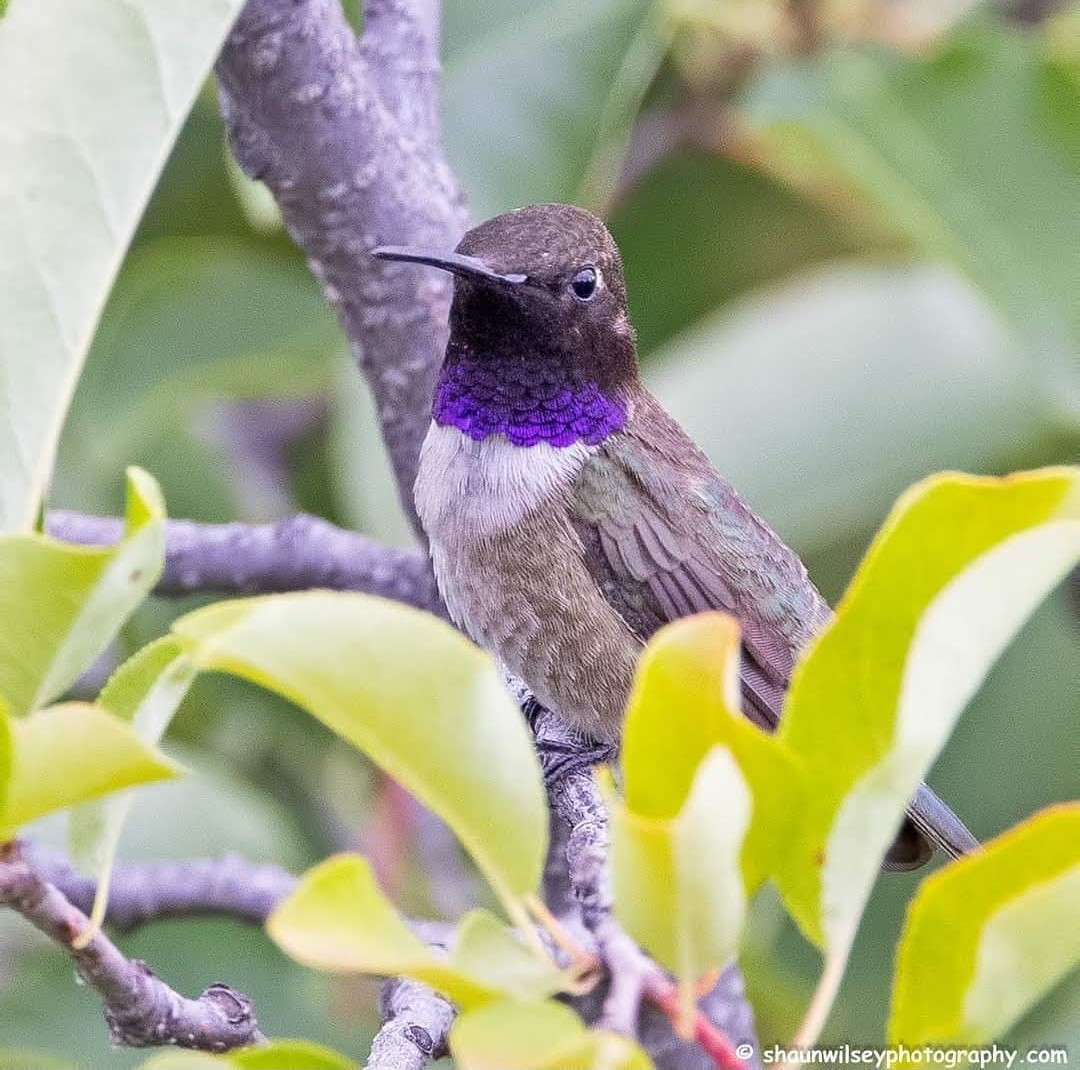This post contains affiliate links.
What types of hummingbirds are found in Wyoming?
There are 9 hummingbird species found in Wyoming.
- Anna’s – (Calypte anna)
- Black-chinned – (Archilochus alexandri)
- Broad-billed – (Cynanthus latirostris)
- Broad-tailed – (Selsaphoris platycercus)
- Calliope – (Selasphorus calliope)
- Rivoli’s (Magnificent) – (Eugenes fulgens)
- Ruby-throated – (Archilochus colubris)
- Rufous – (Selasphorus rufus)
- White-eared Hummingbird (Hylocharis leucotis)
According to the United States Department of Agriculture (USDA) and the Rockies Audubon, these are the 9 hummingbird species a Wyomingites might see in their home state.
Wyoming, known as The Equality State, is “home” to 3 out of the 9 hummingbird species seen in Wyoming. They are the Black-chinned, Broad-tailed, and Calliope hummingbirds.
According to the United States Department of Agriculture (USDA), these 3 hummingbirds breed, nest, and raise their families in Wyoming.
The four most common hummingbirds seen in Wyoming, according to the Bird Conservancy of the Rockies, are:
- Black-chinned hummingbird
- Broad-tailed hummingbird
- Calliope hummingbird
- Rufous hummingbird
While it is easy to assume all hummingbirds are the same when we see them only as a jewel-toned flash of color as they jet around our hanging flowers and porches; they have different temperaments, varied nesting habits, diverse coloring and reside in multiple geographical ranges.
Hummingbirds are known to exist within certain established ranges, either as year-round natives or as part of a migratory cycle.
Categories of Hummingbirds:
There are 3 categories of hummingbirds found in Wyoming. Year-round natives, seasonal, and rare “Vagrant” hummingbirds.
Year-round hummingbirds in Wyoming are rare, but they can survive sub-freezing temperatures and even a few days of sub-zero temperatures.
Seasonal hummingbirds are those hummingbirds that choose the long flights south in the winter.
“Vagrant” hummingbirds are those hummingbirds that show up in geographical areas far outside their established range and are known in the ornithological circles as “vagrants”.
Year-Round/Native Hummingbirds:
These 4 hummingbirds may be seen in Wyoming year-round:
- Black-chinned hummingbird (most migrate south in winter)
- Broad-tailed hummingbird (most migrate south in winter)
- Calliope hummingbird (most migrate south in winter)
- Rufous hummingbird (most migrate south in winter)
Year-round hummingbirds in Wyoming are rare but they can survive sub-freezing temperatures and even a few days of sub-zero temperatures.
Most will choose to migrate south for the winter but some of the brave and hardy hummingbirds may choose to tolerate the cold. The ones that choose to tolerate the cold feel this option is less life-threatening than flying thousands of miles south for the winter.
Seasonal Hummingbirds:
Wyomingites will see these 4 seasonal hummingbird species from early April to the end of September.
- Black-chinned hummingbird (most migrate south in winter)
- Broad-tailed hummingbird (most migrate south in winter)
- Calliope hummingbird (most migrate south in winter)
- Rufous hummingbird (most migrate south in winter)
Rare/Vagrant Hummingbirds:
These hummingbirds are outside of their normal geographic range when found in Wyoming, but are occasionally spotted.
Not only do these species of hummingbirds have a wide variety of specific geographic ranges, but they are also known to sometimes interbreed with each other, creating hybrids.
Click links to The Cornell Lab’s sightings map to view where in Wyoming they were seen.
- Anna’s – (Calypte anna)
- Broad-billed – (Cynanthus latirostris)
- Rivoli’s (Magnificent) – (Eugenes fulgens)
- Ruby-throated – (Archilochus colubris)
- White-eared Hummingbird (Hylocharis leucotis)
Because of human intervention, in the form of feeding stations and the transplant of exotic flowers in residential areas, some hummingbirds in mild climates are staying rather than migrating.
Read on to find out more about each of these hummingbird species as well as where and when they can be found in Wyoming.
Year-Round/Native Hummingbirds
Year-round hummingbirds from Wyoming, although rare, are the same as the seasonal hummingbirds listed below.
Seasonal Hummingbirds
BLACK-CHINNED HUMMINGBIRD – (Archilochus alexandri)
Conservation Status: Least concerned
Kingdom: Animalia
Phylum: Chordata
Class: Aves
Order: Apodiformes
Family: Trochilidae
Genus: Archilochus
Species: A. alexandri
According to the United States Department of Agriculture (USDA), Black-chinned hummingbirds breed east of the Cascade mountain range and are a common summer breeding resident to Wyoming. Their breeding grounds and habitat are closely related to their cousin counterparts, the Ruby-throated hummingbird.
They hybridize and readily crossbreed with other hummingbird species. Black-chinned hummingbirds can live up to 10 years, which is extremely long in comparison to other birds and animals of similar size.
Black-chinned hummingbird’s scientific name is in commemoration of Dr. Alexandre, a French doctor who was the first to discover the species in Mexico.
Male Black-chinned hummingbirds are identified by their royal purple gorget, showing a small glimmer of color right near the neckline like a buttoned-up shirt. Since the male purple gorget or throat color is minimal, at times they can appear to look all black. They have metallic green on their backs and flanks with white on their underbelly. Their dark tail is forked and their bill is black. Their size is 3.25 inches to 3.5 inches in length and weigh 2.8-5.6 grams.
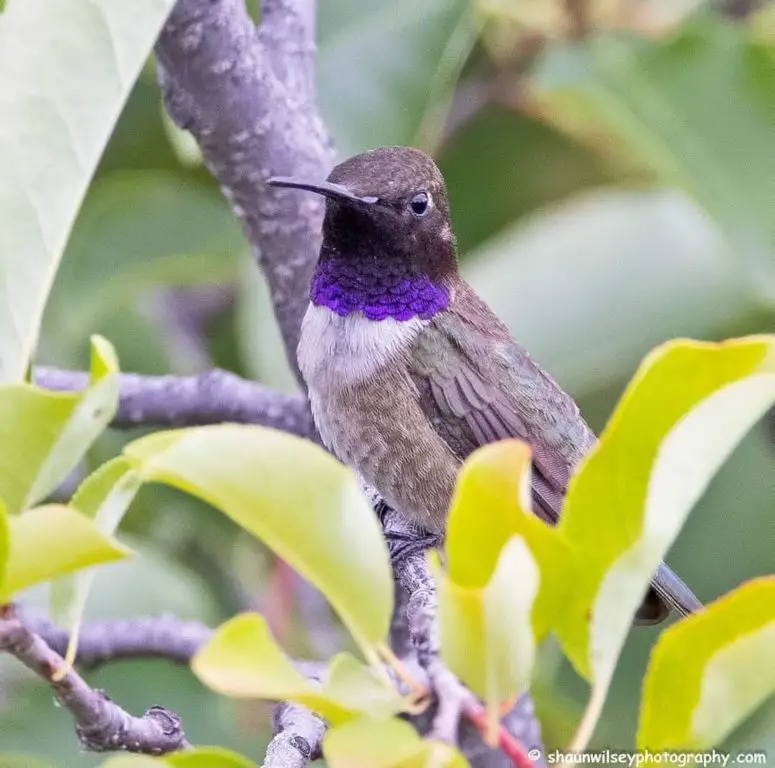
Photo by: shaunwilseyphotography
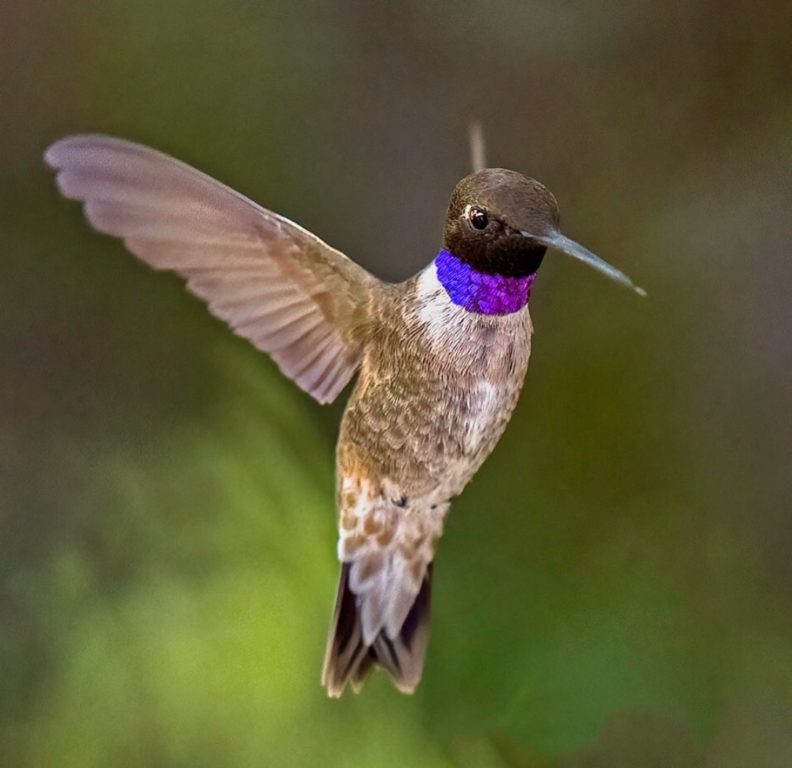
Photo by: sony_alpha_male
The gorget on a male hummingbird is named after the protective metal piece in a suit of armor that covers the wearer’s throat to prevent injury when in battle. Since male hummingbirds are very aggressive with each other when fighting for their own territory, this name is appropriate and fitting to describe their physical attributes.
Female and juvenile Black-chinned hummingbirds have no gorget, but have a dark rounded tail with white tips and beige margins on the dorsal feathers that turn dark black as they mature. Their head and back reflect the dull metallic marbled colors of beige, greens, whites, yellow-green, and dark browns, looking similar to the scales found on a snake.
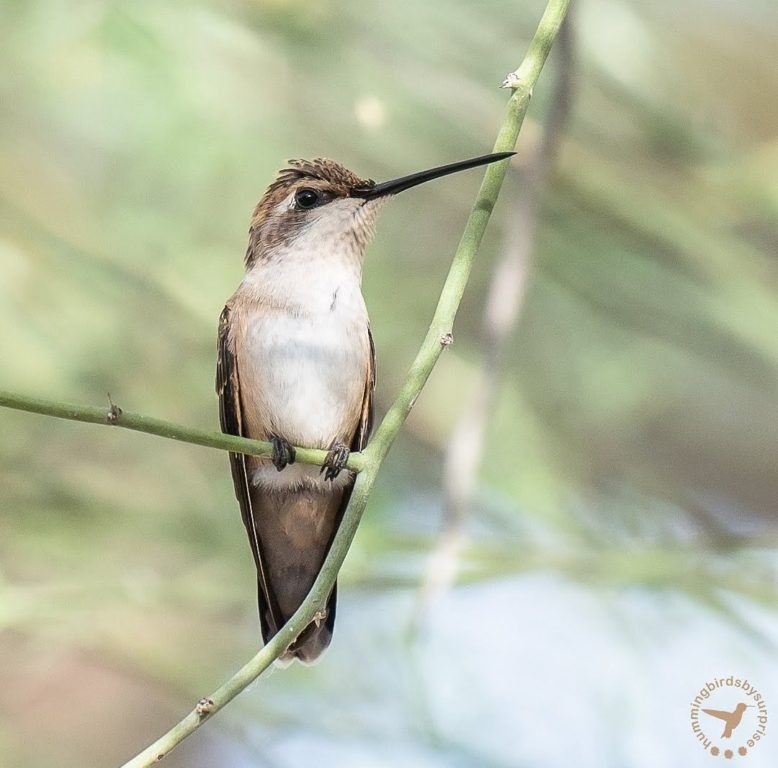
Photo by: hummingbirdsbysurprise
Black-chinned hummingbirds have the smallest known genetic material of all living vertebrates or mammals.
Because of their small size, Black-chinned hummingbirds are at risk of being preyed upon by larger insect-eating birds or larger insects such as a praying mantis. Black-chinned hummingbirds are known to use a decoy strategy by constructing their nest near larger and more active bird nests reducing the chance of predators around their nest.
See my article: 10 Common Things That Kill Hummingbirds
While typically a territorial species, if Black-chinned hummingbirds find themselves in an area with a large population of hummingbirds and food sources of plenty, their territorial behaviors will reduce and they will play nice and share.
See pictures of male, female and juvenile Black-chinned hummingbirds here…..
Hear sounds of Black-chinned hummingbirds here…..
BROAD-TAILED HUMMINGBIRD – (Selsaphoris platycercus)
Conservation Status: Least concerned
Kingdom: Animalia
Phylum: Chordata
Class: Aves
Order: Apodiformes
Family: Trochilidae
Genus: Selsaphoris
Species: S. platycercus
The Broad-tailed hummingbird, though usually residing in Mexico and as far south as Guatemala during the winter, is a common summer breeding resident to Wyoming.
They have a migrant and non-migrant population that begins in the south of Mexico. The ones that migrate north to breed will do so during spring migration and will pass through Arizona, Colorado, Wyoming, Idaho and reach as far north as Montana.
Once the breeding season is complete, Broad-tailed hummingbirds once again depart and begin their southbound fall migration to Mexico to winter and meet up with their non-migrant population.
Male Broad-tailed hummingbirds have an iridescent ruby-red gorget. Both males and females Broad-tailed hummingbirds have green topside and pale underbellies with bright white eye rings and broadly rounded tails. Their size is medium build and ranges from 3.3 inches to 3.8 inches in length and weighs 3.6 grams.
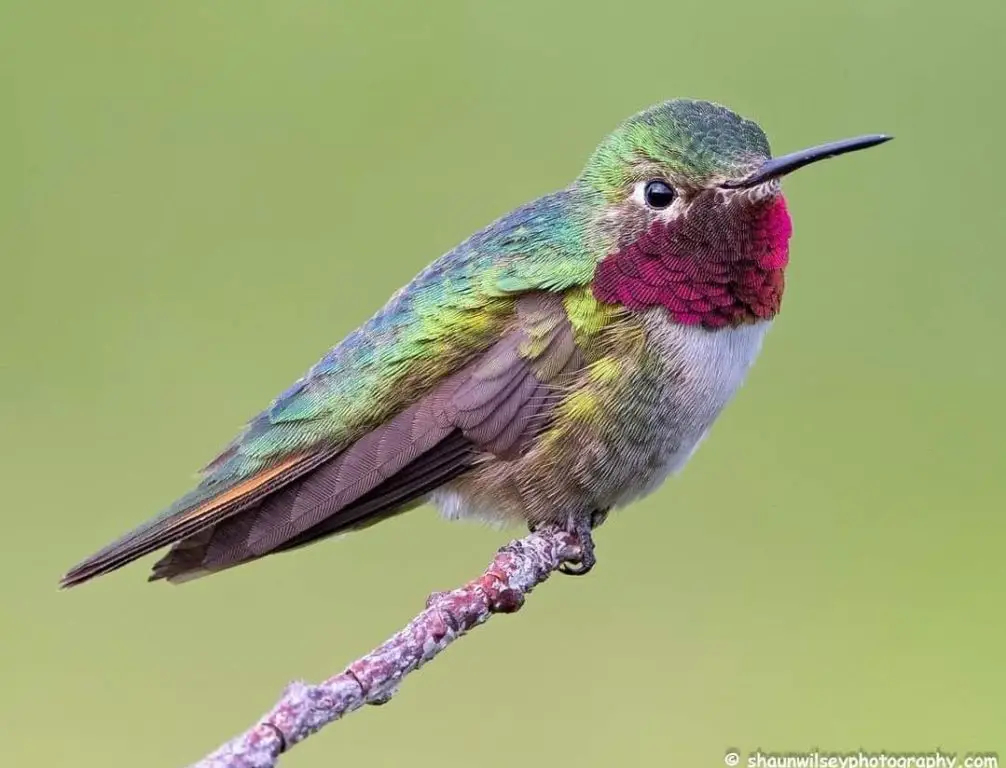
Photo by: shaunwilseyphotography
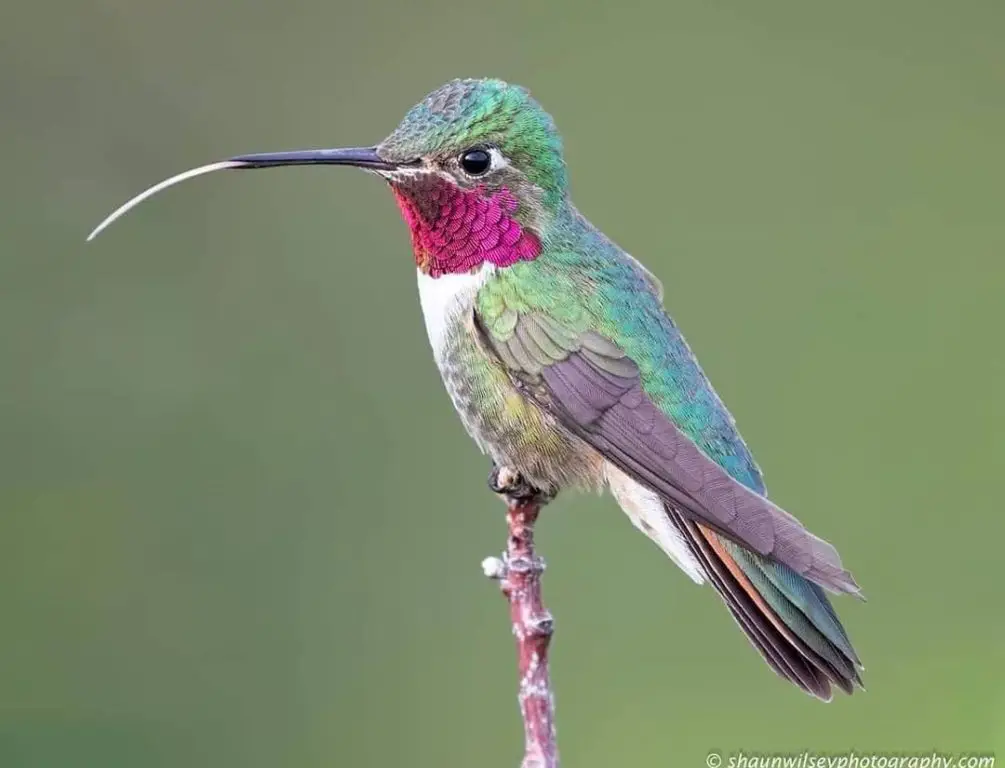
Photo by: shaunwilseyphotography
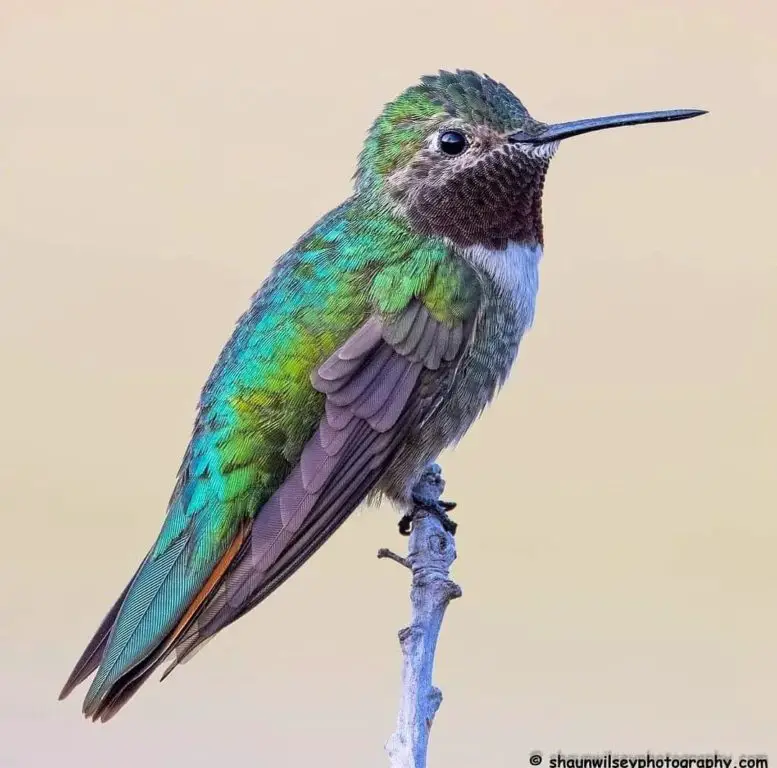
Photo by: shaunwilseyphotography
Note: Male Broad-tailed hummingbirds usually have an iridescent ruby-red gorget, however depending on the lighting their gorget can appear dark in color, as shown above. Do not be fooled by the lighting.
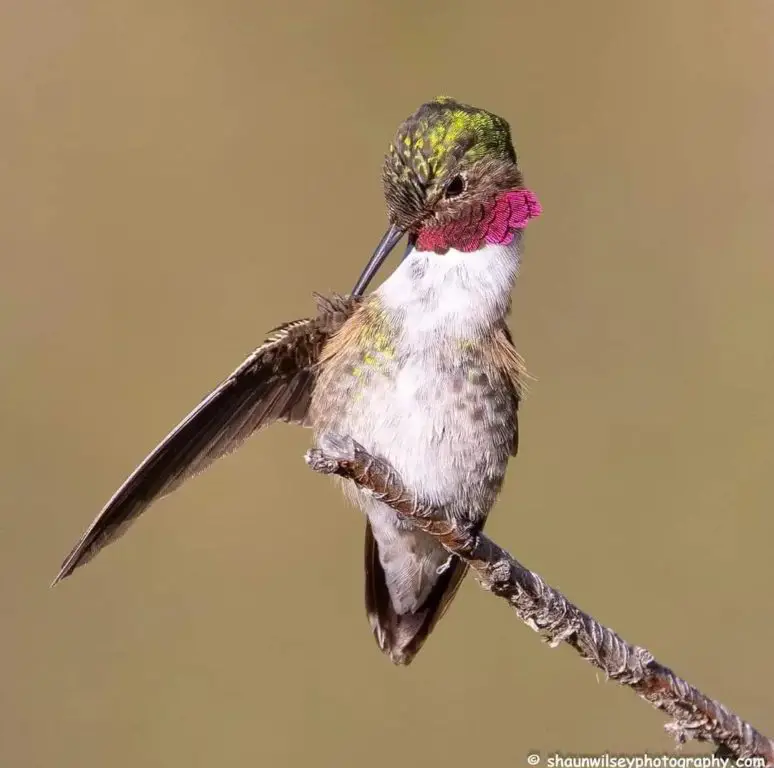
Photo by: shaunwilseyphotography
Note: Preening flight feathers is an important daily routine to maintain hygiene and to keep the feathers flexible, strong, in alignment, and parasite-free.
Female and juvenile Broad-tailed hummingbirds have no gorget, but have green topsides from their head to their tail and pale to beige underbellies with bright white eye rings and broadly rounded tails.
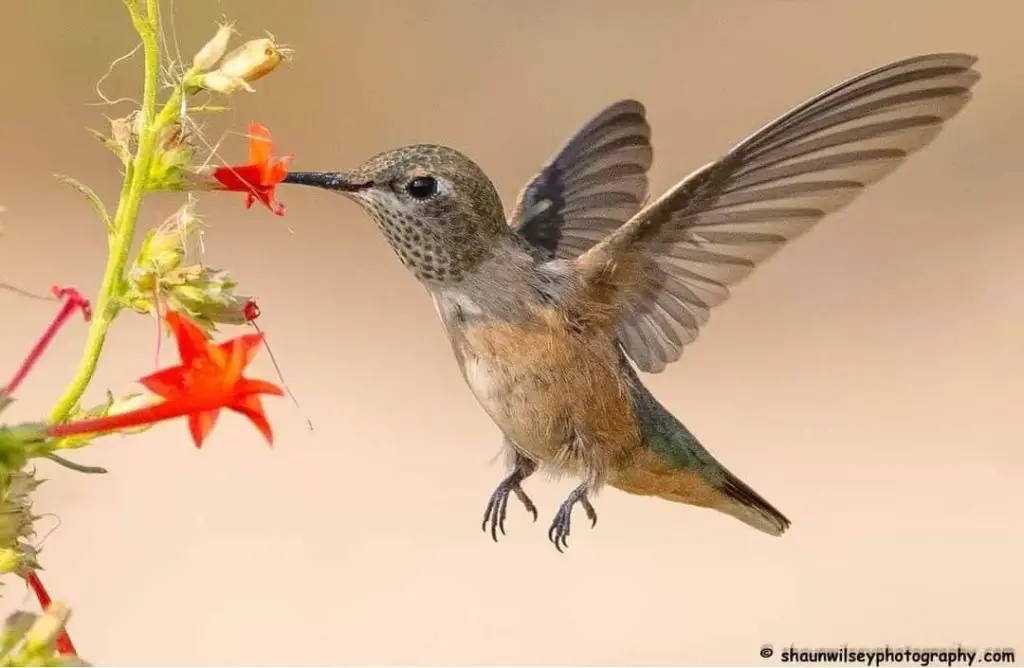
Photo by: shaunwilseyphotography
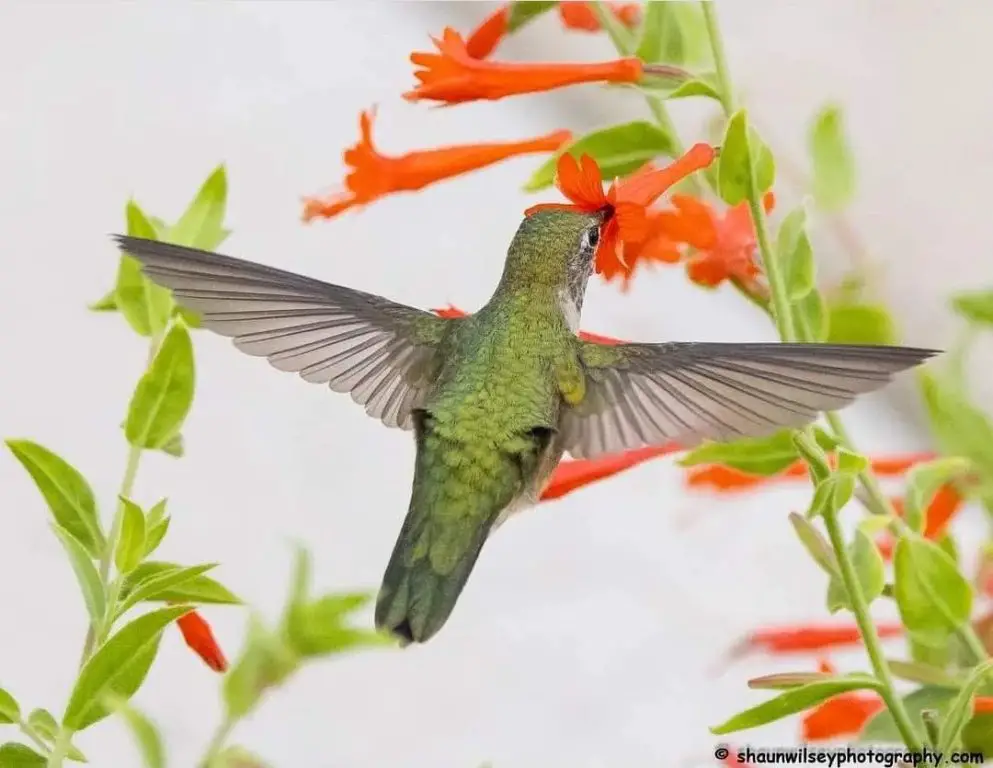
Photo by: shaunwilseyphotography
Note: Hummingbirds beat their wings 80 beats per second. While hovering, the wings move back and forth forming a figure eight or infinity symbol. This powerful movement creates a fanning and ruffling effect as noticed by the feathers on both sides of her lower back. The flower is Scarlet Mint.
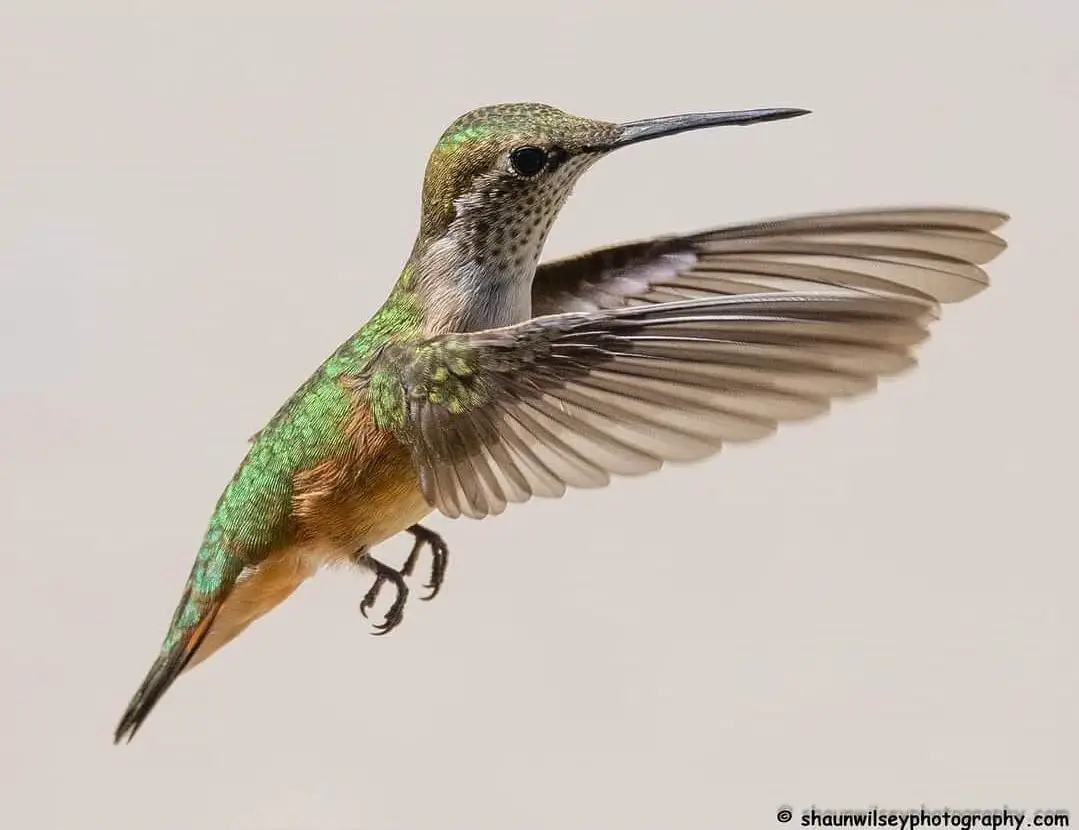
Photo by: shaunwilseyphotography
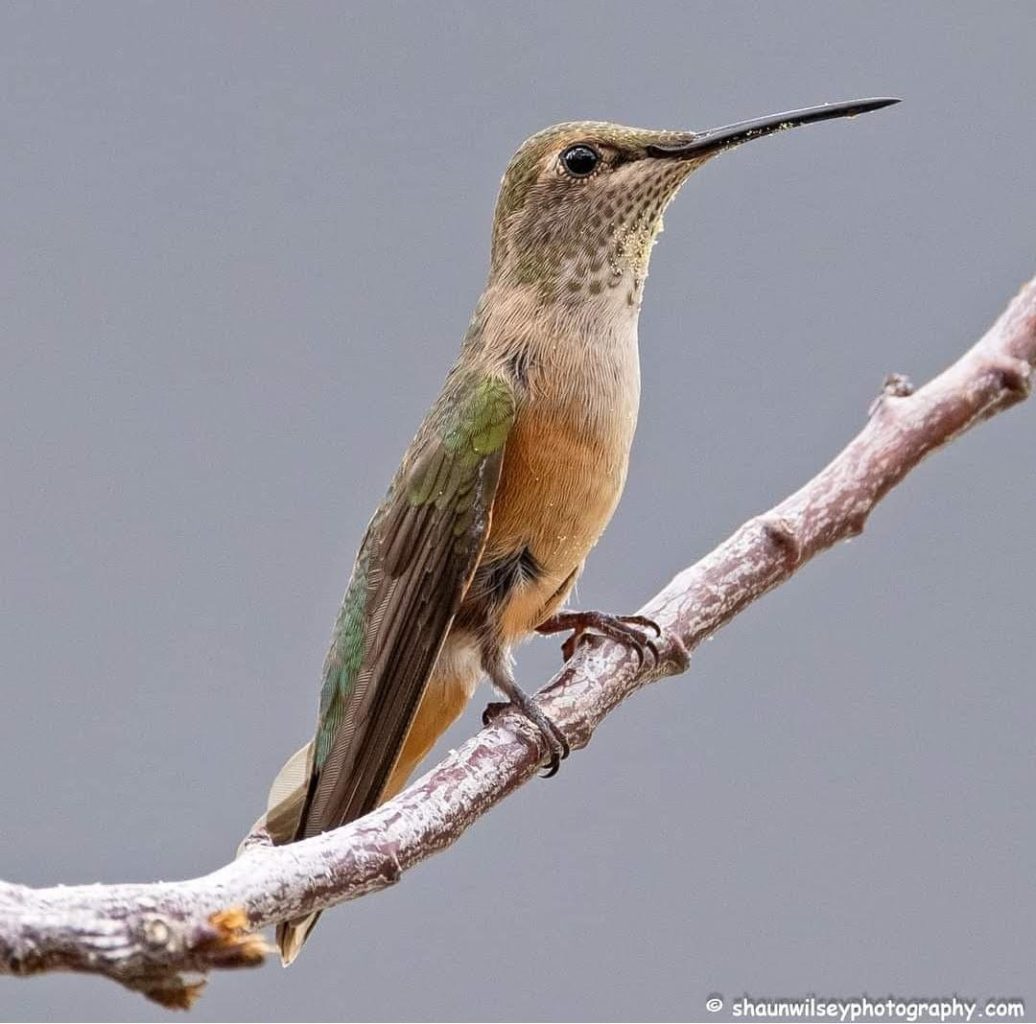
Photo by: shaunwilseyphotography
Note: The thick blanket of pollen on its bill and throat. This juvenile Broad-tailed hummingbird has been busy pollinating and drinking nectar from flowers to sustain its high metabolism.
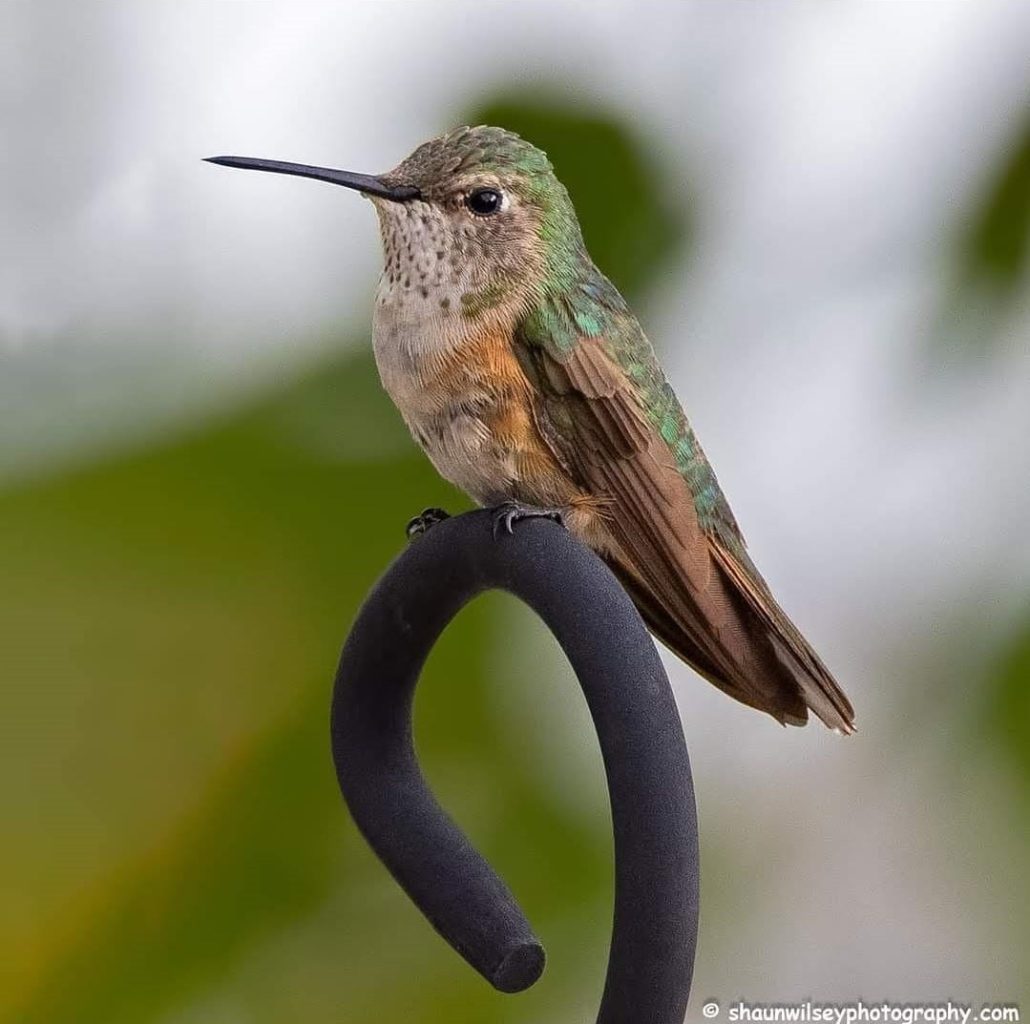
Photo by: shaunwilseyphotography
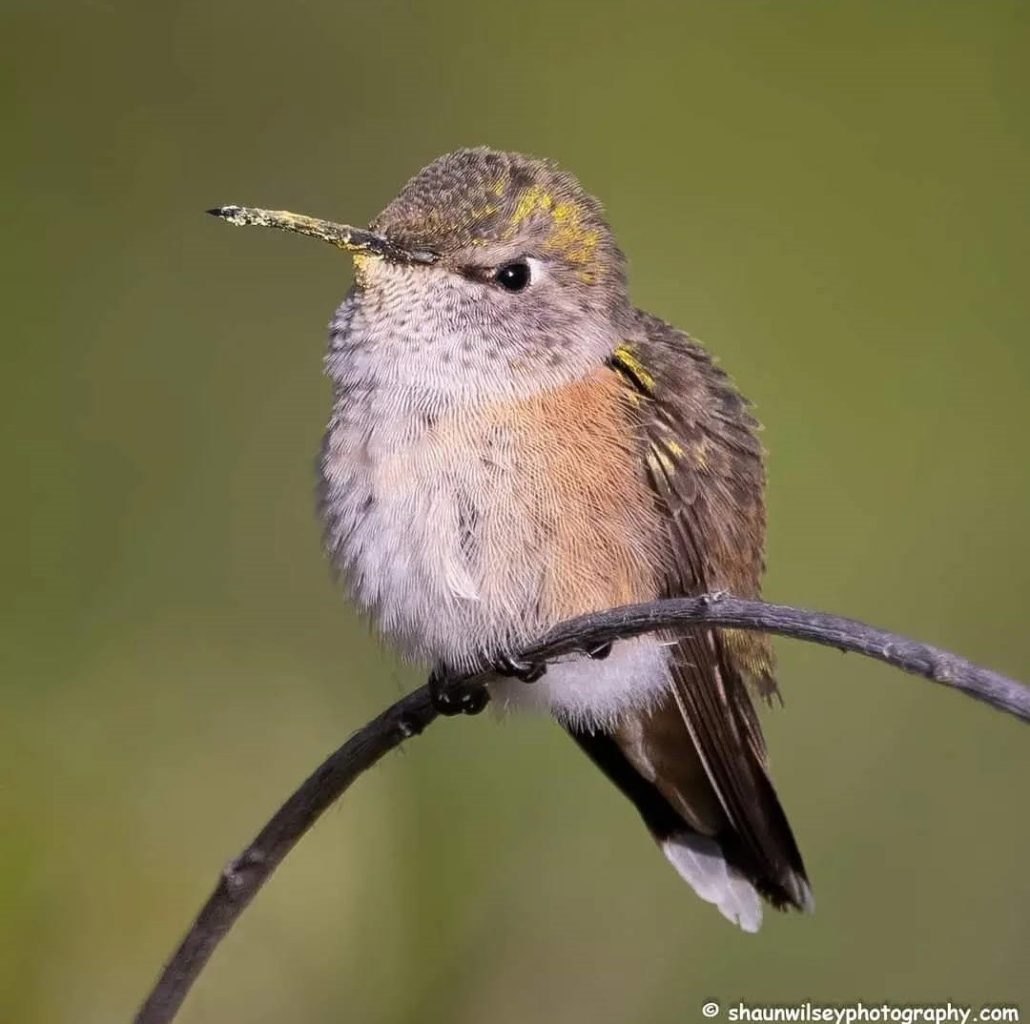
Photo by: shaunwilseyphotography
Note: The newly white fluffy down feathers on this baby/juvenile Broad-tailed hummingbird’s bottom. Also notice the nice fat reserves they have accumulated by being fed by their diligent mother which will sustain it through adolescence.
The Broad-tailed species of hummingbird favors habitats in the understory of mature forest woodlands such as pine and oak groves. They chose to nest on the branches of trees and have been known to return to the same nesting ground each year, roughly 70% of the time.
Their breeding time coincides with the peak time of flowering native plants for maximum food resource availability. Their favorite nectar producing flower plants include: Red Columbine, Indian Paintbrush, Sage varieties, Currants and Scarlet Mint.
Broad-tailed hummingbirds commonly nest in Wyoming during the summer and their nests are often located over riparian corridors.
They are promiscuous and do not form any kind of a pair bond between male and female birds and again the female raises the young alone.
The Broad-tailed hummingbird has suffered a decline in population since the 1990s, but presently, its population is stable, and it has been shown to have adapted to human habitat encroachment.
See pictures of male, female, and juvenile Broad-tailed hummingbirds here…..
Hear sounds of Broad-tailed hummingbirds here…..
CALLIOPE HUMMINGBIRD – (Selasphorus calliope)
Calliope hummingbirds are a common summer breeding migrant to Wyoming and tend to breed in the higher elevations of the Rocky Mountains.
Calliope hummingbirds are the smallest long-distance migratory bird in the world. They arrive in the spring as early as April passing through the Pacific Flyways.
On their southbound journey in the fall, they pass through the Pacific and Rocky Mountain Flyways towards their wintering destination in Mexico.
Calliope hummingbirds are named after a Greek mythological muse, who represented poetry and eloquence. Calliope means “beautiful voice” in ancient Greek.
Male Calliope hummingbirds are easily identified by their iridescent purple crown and long striking spaced outline row of feathers that project down the sides of their throat. Like many hummingbirds, the backs are metallic green and these birds measure 3 inches in length and weigh 2-3 grams.
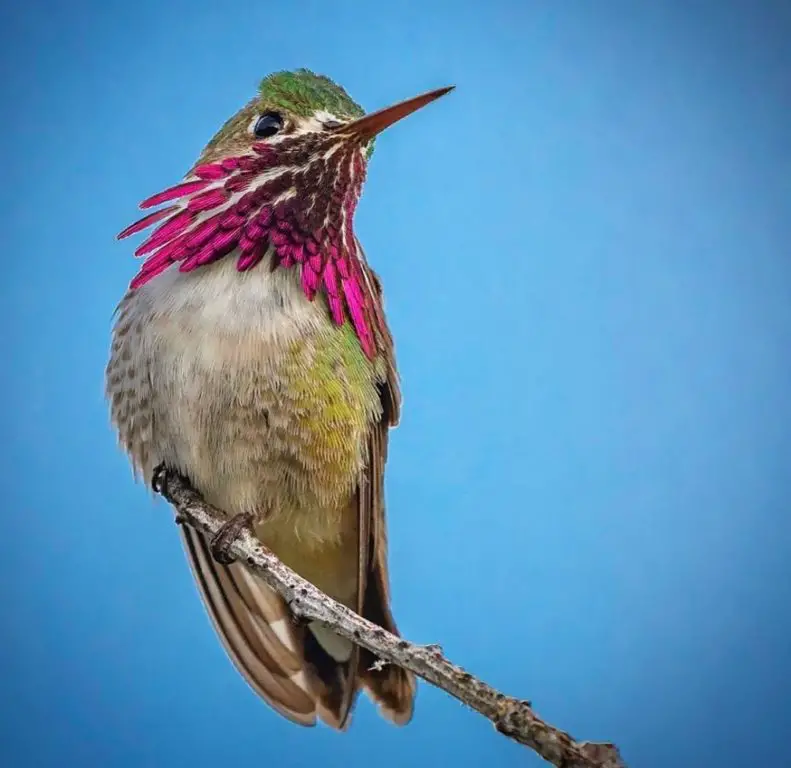
Photo by: sony_alpha_male
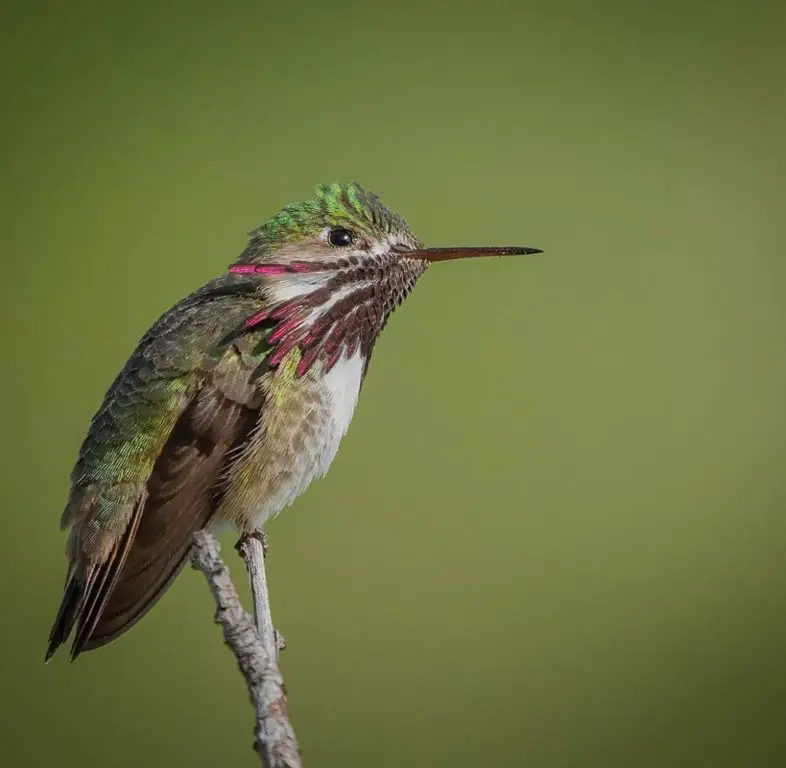
Photo by: sony_alpha_male
Note: This juvenile male Calliope’s bright throat feathers are slowly coming in.
Female Calliope hummingbirds have gray-green crowns and buff-colored flanks which are the underbelly or wing of a bird. Females sport dark tails with white tips.
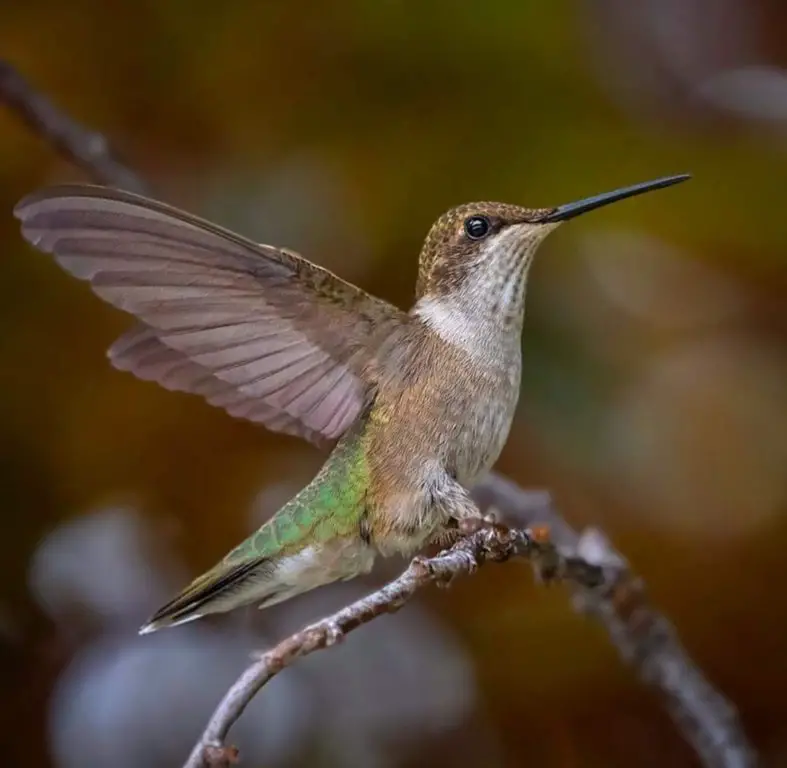
Photo by: sony_alpha_male
Like many hummingbirds, Calliopes communicate not just by their song, but also by manipulating their feathers during flight to make different buzzing noises that act as a form of language and communication.
Male Calliope hummingbirds establish a breeding territory and mate with every available female hummingbird that accepts his courtship.
During nest construction, the female Calliope chooses tops of pine cones as her building site. She will also dismantle nests from previous seasons and recycle them in her new nest along with stealing materials from the nests of other birds in order to construct her own.
Therefore, female Calliopes are often chased and attacked by larger and more aggressive hummingbirds such as Allen’s and Rufous hummingbirds. To avoid these attacks, the Calliope maintains a relatively low profile in comparison to other species.
Because Calliope hummingbirds have a more restricted wintering range than most hummingbirds, they are particularly vulnerable to habitat loss and natural disasters, such as climate change and wildfires.
During a capture and release banding operation in Idaho, the oldest living recorded female Calliope hummingbird was 8 years and 11 months old when she was captured twice, once in 2007 and again in 2014.
See my article: 3 Reasons Why Hummingbirds Are Banded
See pictures of male, female and juvenile Calliope hummingbirds here…..
Hear sounds of Calliope hummingbirds here…..
RUFOUS HUMMINGBIRD – (Selasphorus rufus)
Conservation Status: Near threatened
Kingdom: Animalia
Phylum: Chordata
Class: Aves
Order: Apodiformes
Family: Trochilidae
Genus: Selasphorus
Species: S. rufous
Rufous hummingbirds are migrating seasonal hummingbirds that travel through Wyoming to their preferred nesting location.
According to the United States Department of Agriculture (USDA), Rufous hummingbirds migrate as far north as Alaska during the summer. Hummingbird enthusiasts are extremely valuable when they plant flowering plants to attract hummingbirds and provide feeders with homemade hummingbird nectar to contribute to a successful migration. These welcoming habitats provide and ensure safe travels as well as a reliable sanctuary for rest and refueling during their journey.
Fall migration begins in June for some Rufous hummingbirds and they use both travel routes between the Pacific and Rocky Mountain Flyways to reach their southern overwintering destination in Mexico. During spring migration those that choose to travel do so mostly along the Pacific Flyway.
The Rufous hummingbird gets its name from the Latin word rubrum meaning “red” which is used to describe its reddish-brown coloring.
Male Rufous hummingbirds display an iridescent orange-red gorget with rusty-colored flanks and tails. They have a white to beige underbelly and a black bill. Males can also have green plumage with specks of green color on their rustic-looking backs or on the crown of their head along with chocolate brown dorsal feathers. Their size is 2.8 inches to 3.5 inches in length and weighs 3.2 grams.
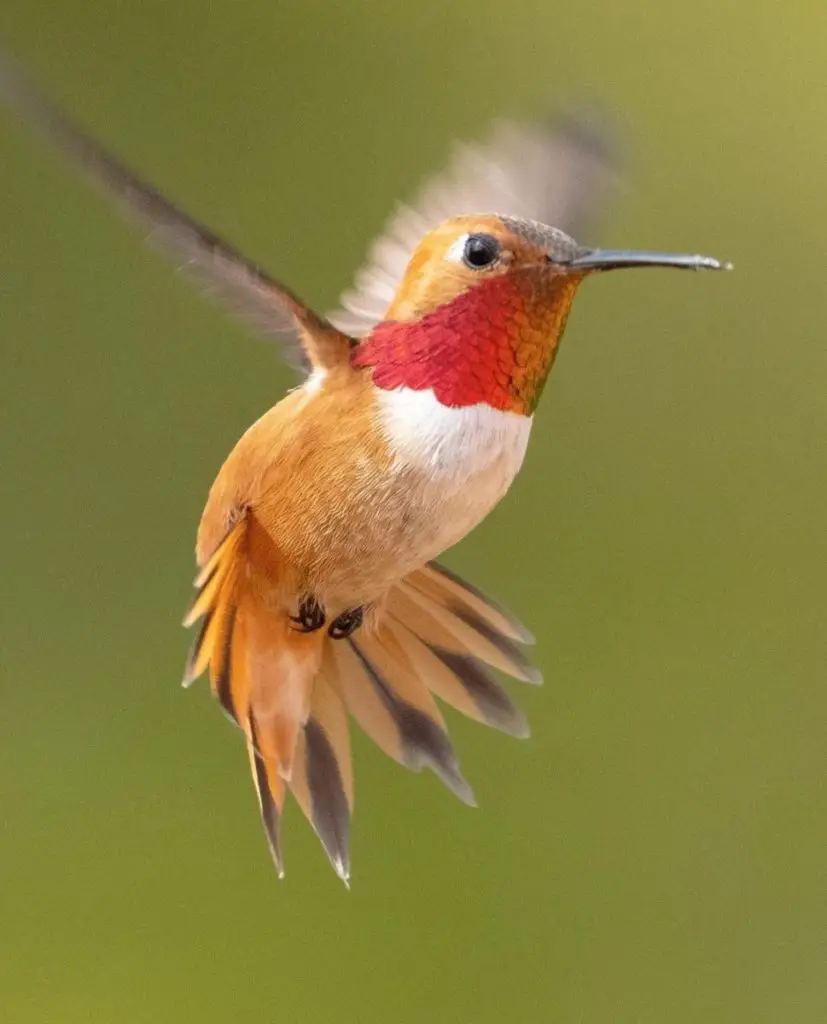
Photo by: jace_the_bird_nerd
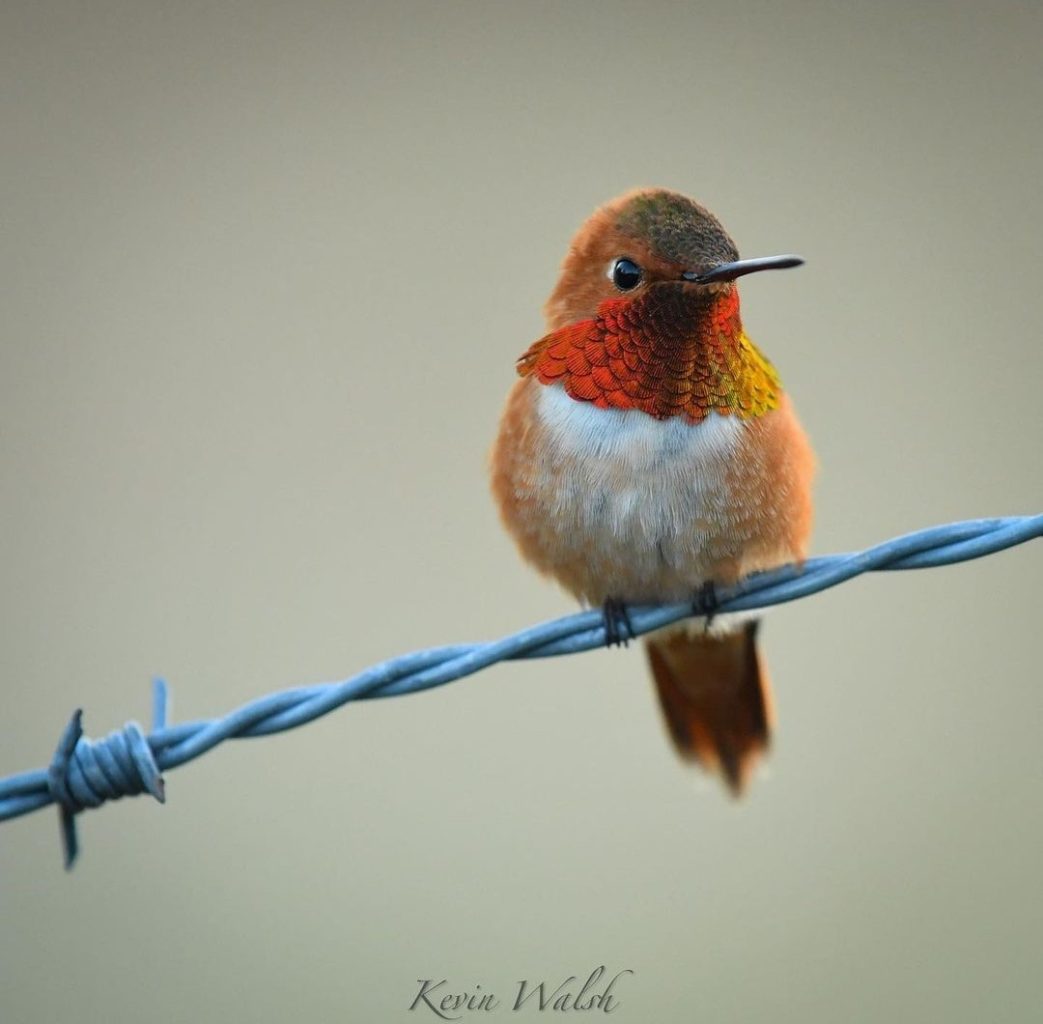
Photo by: Kevin Walsh
Note: The iridescent orange-red gorget.
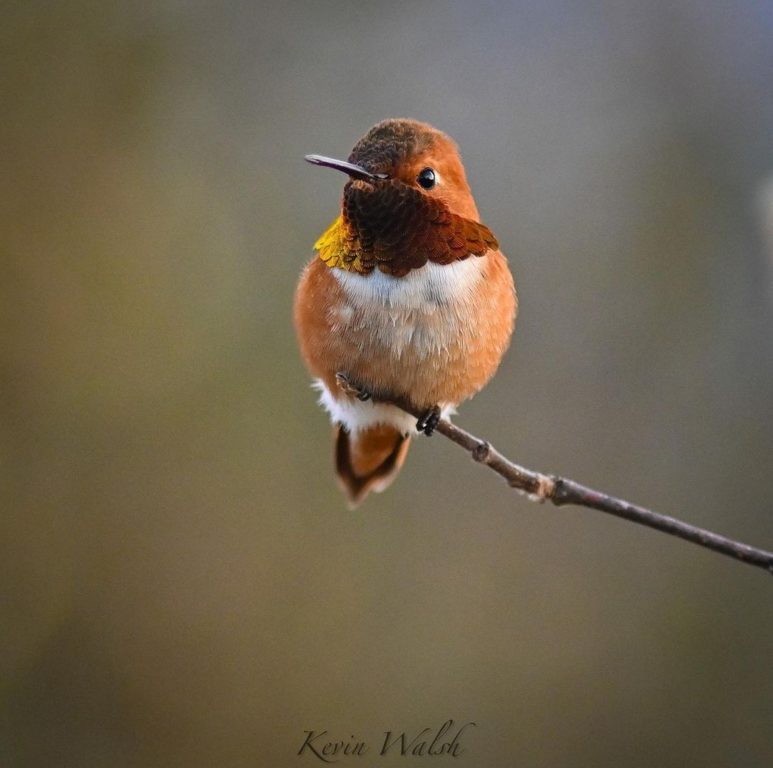
Photo by: Kevin Walsh
Note: The gorget appears chocolate brown in this lighting, however, you can still see a glimmer of his iridescent orange-red gorget with some hints of yellow.
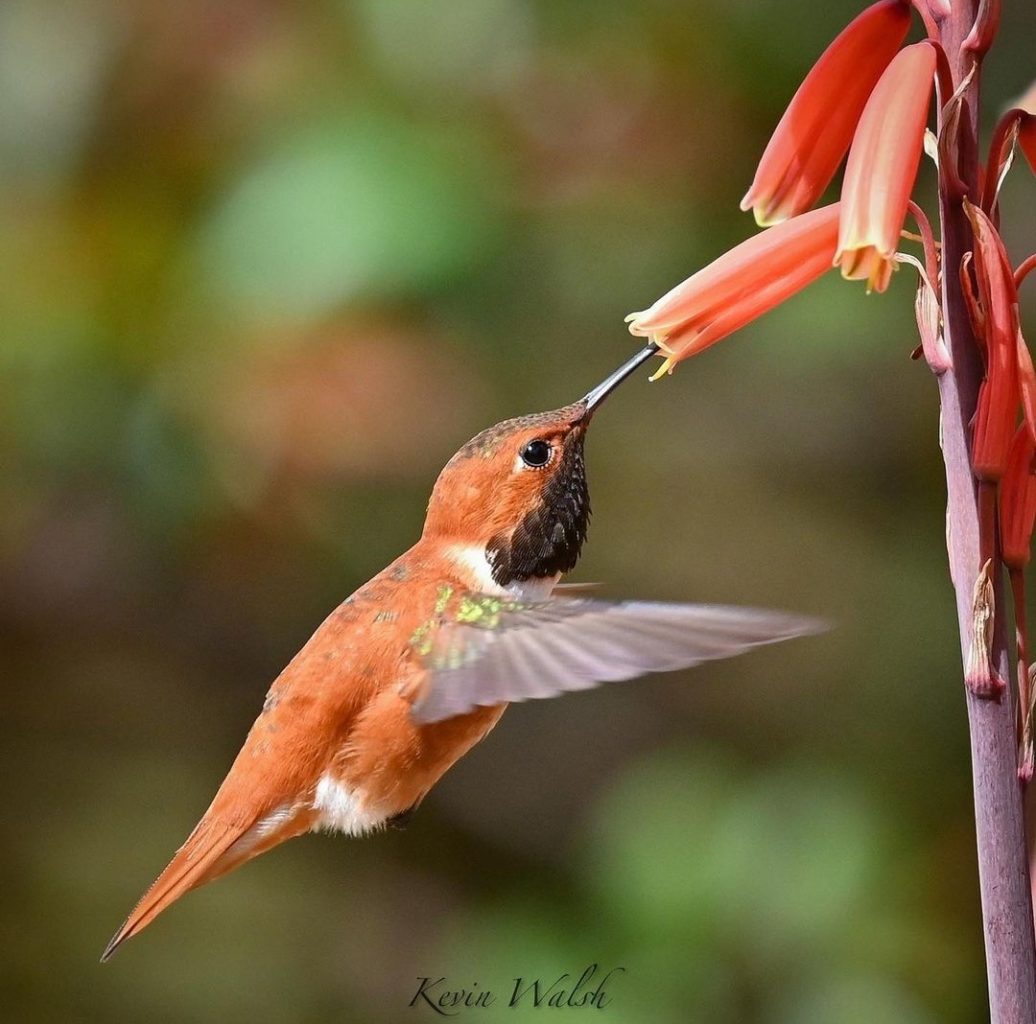
Photo by: Kevin Walsh
Plant: Blue Elf Aloe
Juvenile male Rufous hummingbirds have a rustic look with small iridescent orange specks of color on their throats.
Juvenile Rufous hummingbirds are so similar in coloring and temperament to an Allen’s hummingbird that they are practically indistinguishable in the field. Therefore, identification is established by range rather than appearance.
Female Rufous hummingbirds are green and white with some iridescent orange feathers on their throat. Their tail is dark with white tips and an orange-red base. Female Rufous hummingbirds are slightly larger than the males in anticipation of producing offspring.
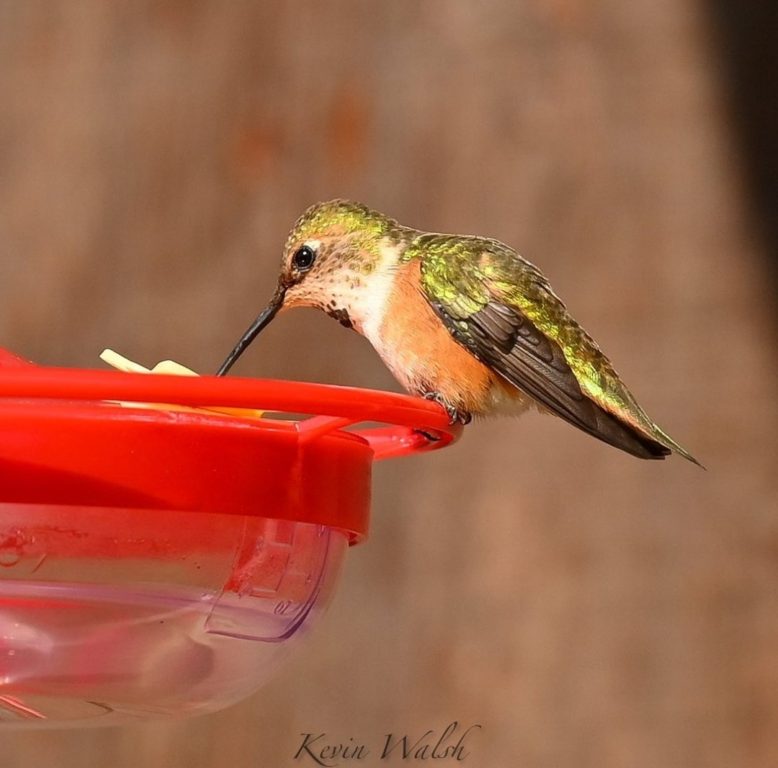
Photo by: Kevin Walsh
They have one of the northernmost breeding ranges of any hummingbird in the world; migrating north from Mexico and nesting as far north as Alaska to breed during the summer months. They are polygamous and will mate with several partners in a season.
Rufous hummingbirds make the longest migrations of any bird in the world. They travel making a clockwise circuit of western America every year that is approximately 3,900 miles.
Rufous hummingbirds are highly territorial and aggressive towards other hummingbirds and animals. They are fearless and have a reputation for chasing away not only other hummingbirds but even large birds and rodents from their favorite feeders. They have been known to even attack squirrels and chipmunks that come too close to their nest.
Their flying acrobatic skills can outmaneuver all other hummingbird species, making them extremely competitive at feeders.
Rufous hummingbirds have excellent memories and have been known to investigate the location of an old hummingbird feeder years after the feeder has been removed.
During a capture and release banding operation in British Columbia, the oldest living recorded female Rufous hummingbird was 8 years and 11 months old.
See my article: 3 Reasons Why Hummingbirds Are Banded
Due to habitat loss in the Pacific Northwest, Rufous hummingbirds are listed at “near threatened” status by the IUCN red list of threatened species.
See pictures of male, female and juvenile Rufous hummingbirds here…..
Hear sounds of Rufous hummingbirds here…..
Rare/Vagrant Hummingbirds
ANNA’S HUMMINGBIRD – (Calypte anna)
Conservation Status: Least concerned
Kingdom: Animalia
Phylum: Chordata
Class: Aves
Order: Apodiformes
Family: Trochilidae
Genus: Calypte
Species: C. anna
Anna’s hummingbirds are named after Anna Massena, Duchess of Rivoli. They are a rare visitor to Wyoming since they are seen mainly in the Western United States.
Male Anna’s hummingbirds are the only hummingbird species in North America with a red crown. They are identified as mostly green, gray, and magenta in color. The males have a flashy and colorful iridescent magenta gorget and crown. Their size ranges from3.5 inches to 4.3 inches in length and they weigh 2.4 to 4.5 grams.
The gorget on a male hummingbird is named after the protective metal piece in a suit of armor that covers the wearer’s throat to prevent injury when in battle. Since male hummingbirds are very aggressive with each other when fighting for their own territory, this name is appropriate and fitting to describe their physical attributes.
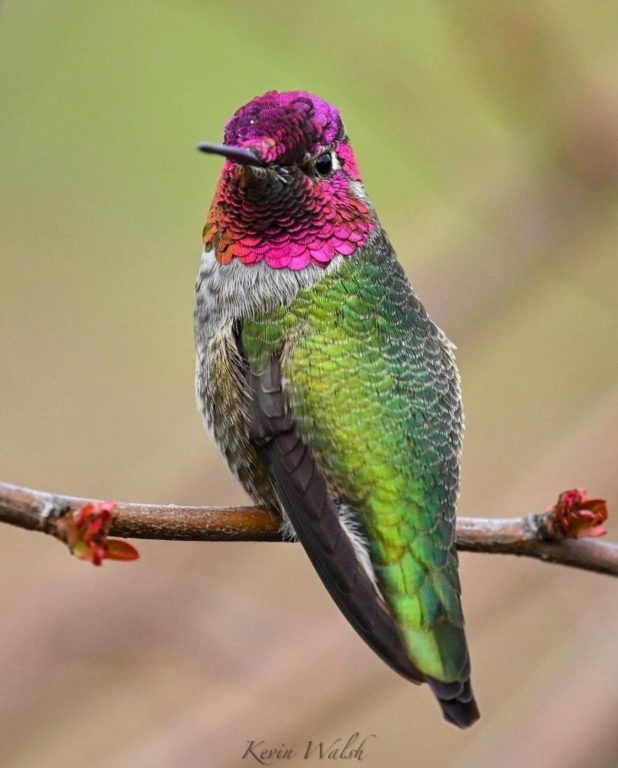
Photo by: Kevin Walsh
Note: The iridescent magenta gorget and crown with a metallic green shiny back.
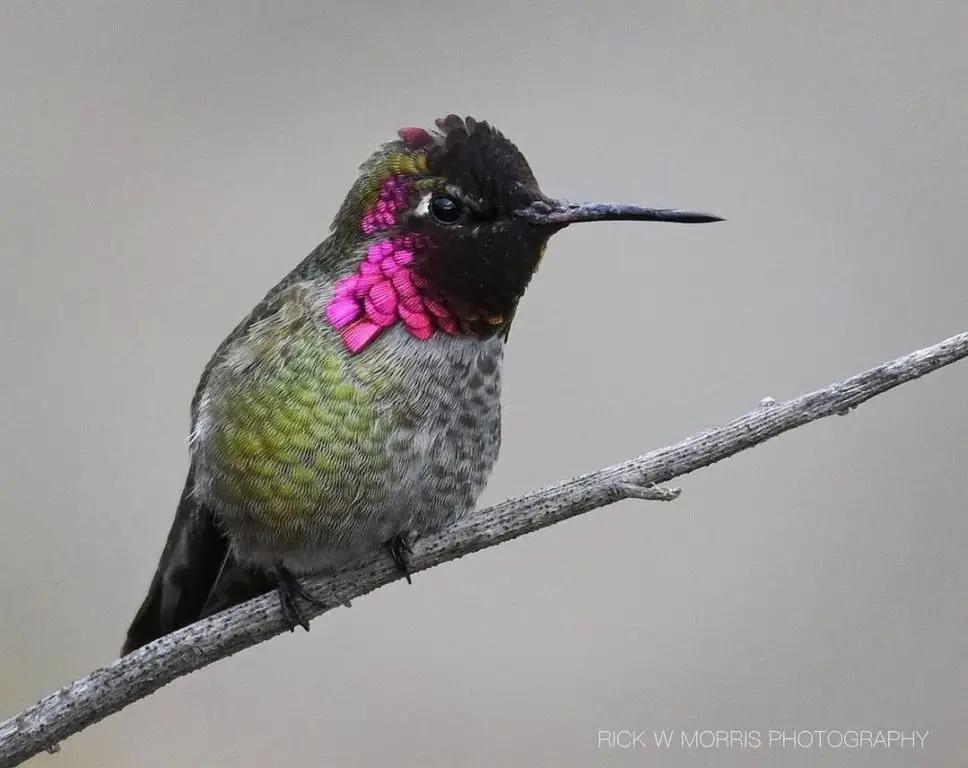
Photo by: rwm_inthewild
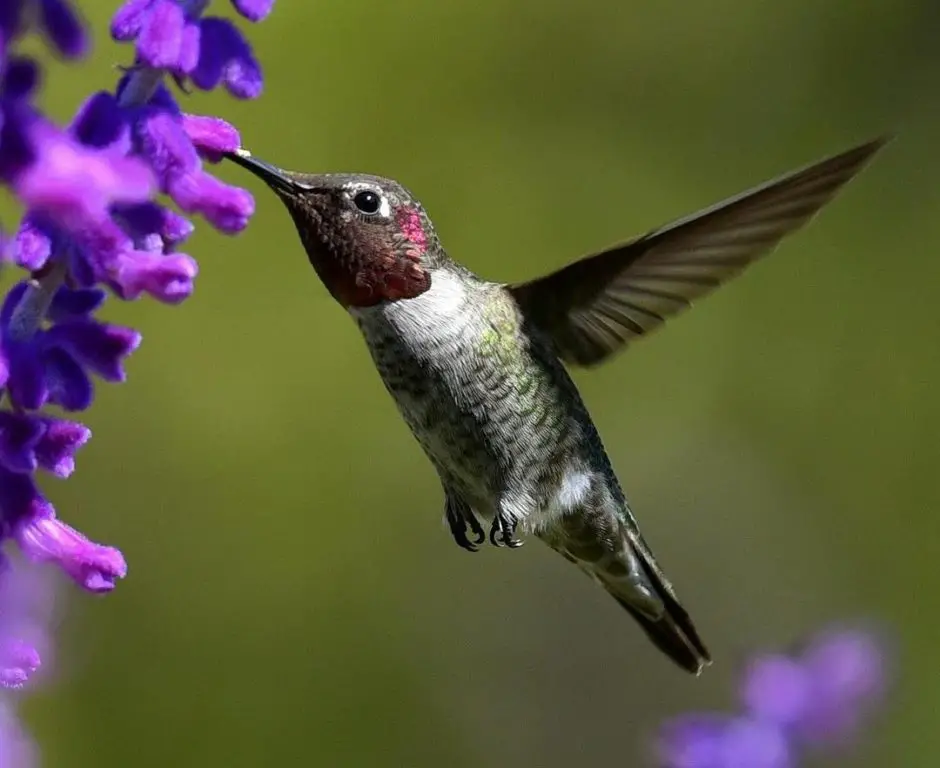
Photo by: rwm_inthewild
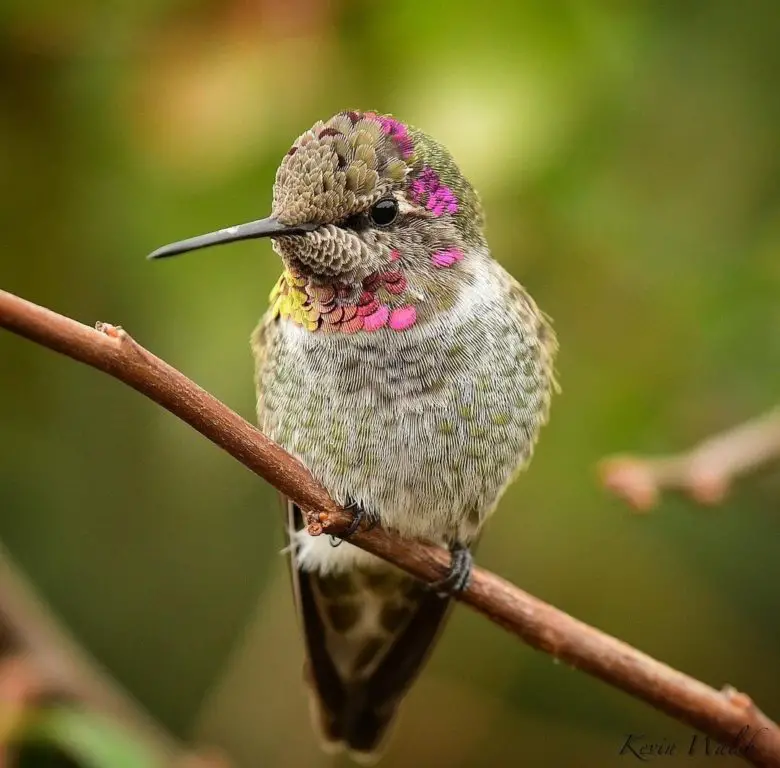
Photo by: Kevin Walsh
Note: This Anna’s hummingbird could be a juvenile in those awkward teenage years or it could be during a molting stage.
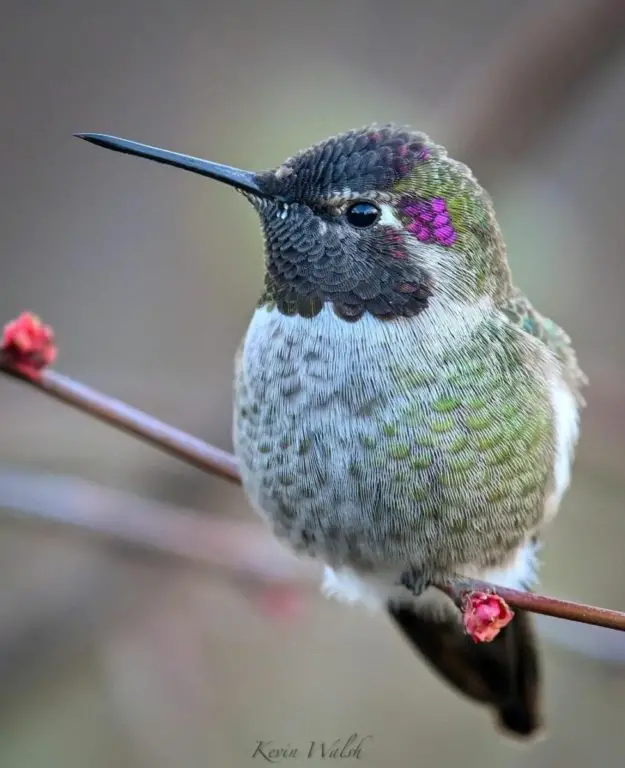
Photo by: Kevin Walsh
Note: This baby/juvenile male Anna’s hummingbird is beginning to show his magenta head feathers near his temple along with some faint color starting to show on his gorget.
Female Anna’s hummingbirds are overall not as colorful as the males, appearing pale green in color. Females can also have a gorget, but it is a smaller patch of magenta. Females tend to have a pale white line over each eye that makes them distinctive.
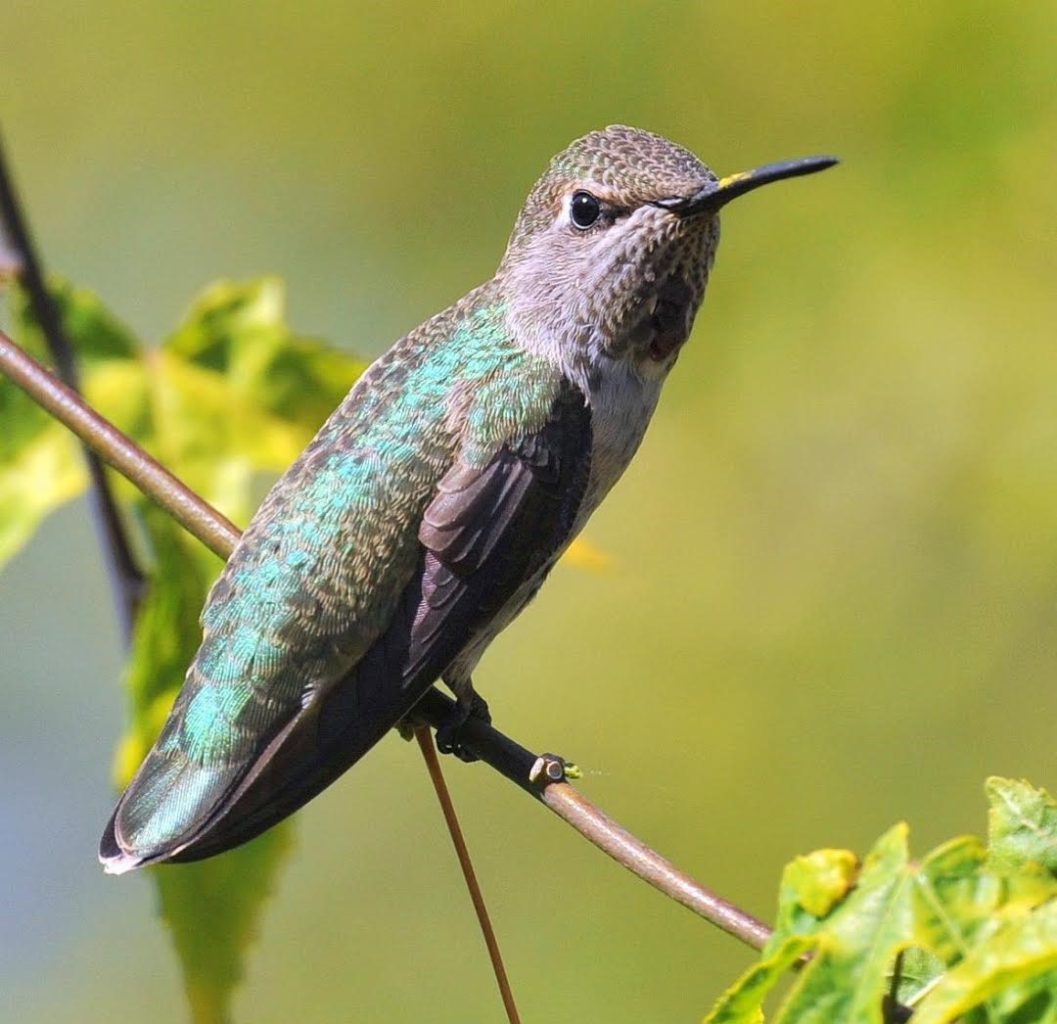
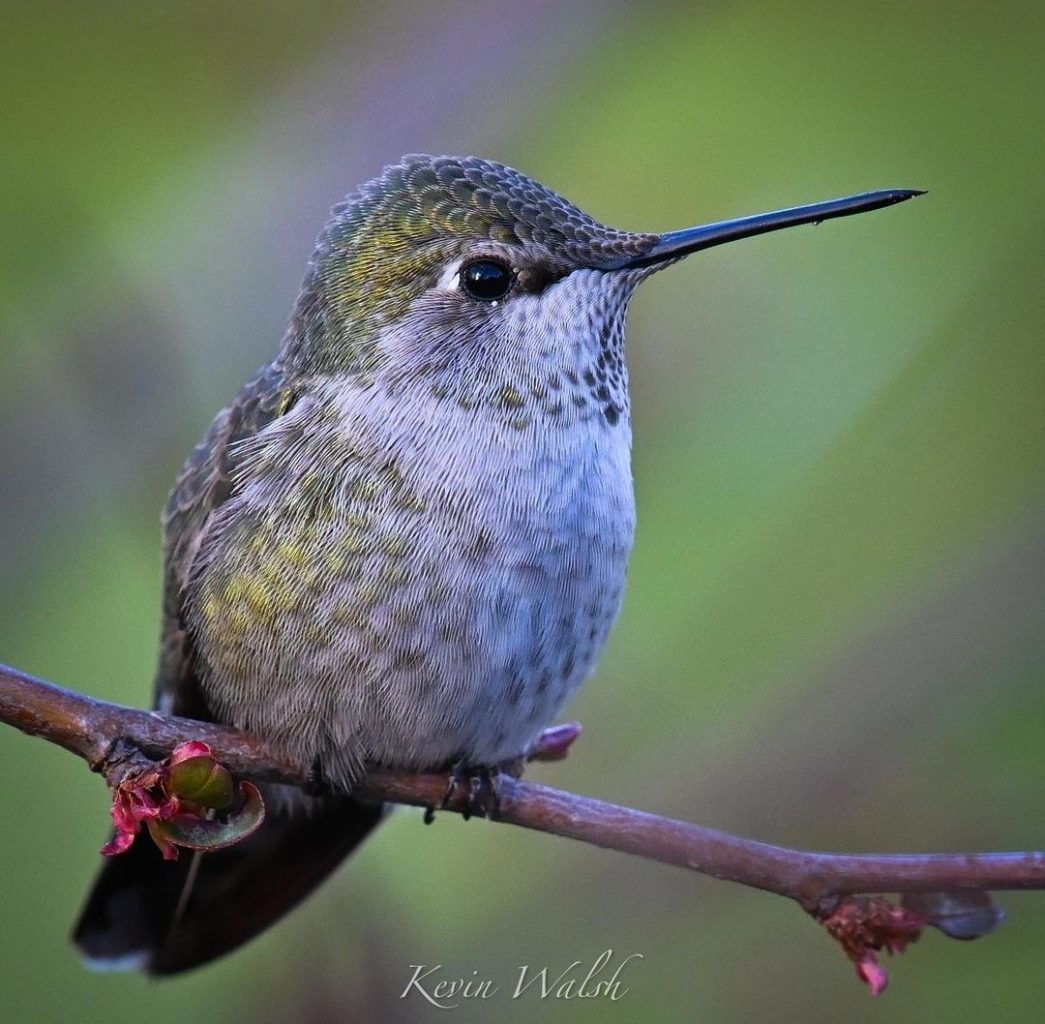
The Anna’s hummingbird predominantly breeds in northern Baja California and parts of Southern California, however, due to the transplanting of exotic ornamental plants in residential areas along the Pacific Coast and Inland Deserts, their breeding range has expanded up the Western Seaboard. Anna’s hummingbirds have the northernmost year-round range of any hummingbird species.
Female Anna’s hummingbirds raise their young with no help from the males.
Anna’s hummingbirds protect their territory with elaborate dives targeted towards predatory birds and even towards people they perceive to be threatening.
See pictures of male, female and juvenile Anna’s hummingbirds here…..
Hear sounds of Anna’s hummingbirds here…..
BROAD-BILLED HUMMINGBIRD – (Cynanthus latirostris)
Conservation Status: Least concerned
Kingdom: Animalia
Phylum: Chordata
Class: Aves
Order: Apodiformes
Family: Trochilidae
Genus: Cynanthus
Species: C. latirostris
Broad-billed hummingbirds are rare/vagrant’s to Wyoming and travel frequently to the United States near the southern Mexican border.
Male Broad-billed hummingbirds feature a bright blue-green gorget that spreads back towards its shoulders. Juvenile males show off a full charcoal dark grey body with flecks of metallic blue on their throat and a light green neck and backside. They sport a long beak that is bright orange-red accented with a signature black tip. Their size ranges from 3.25 inches to 4 inches in length and weighs 3-4 grams.
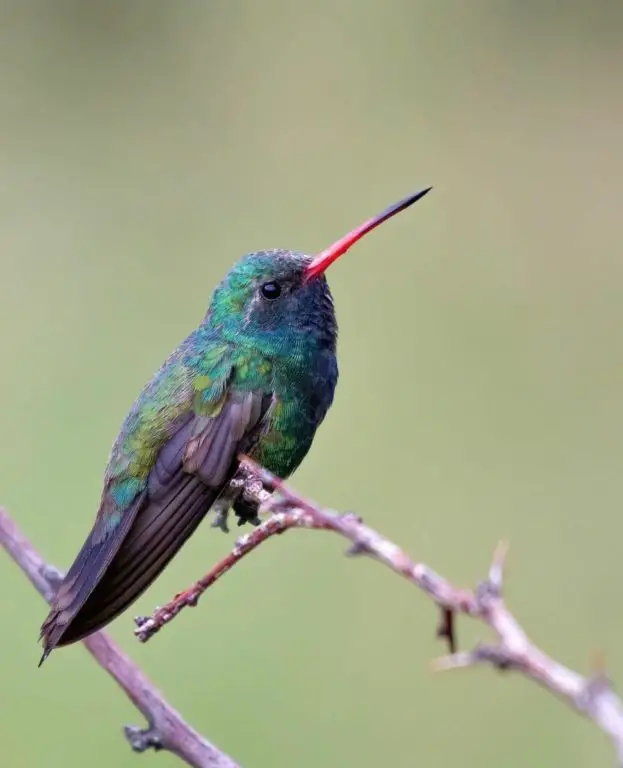
Photo by: Aaron Gomperts
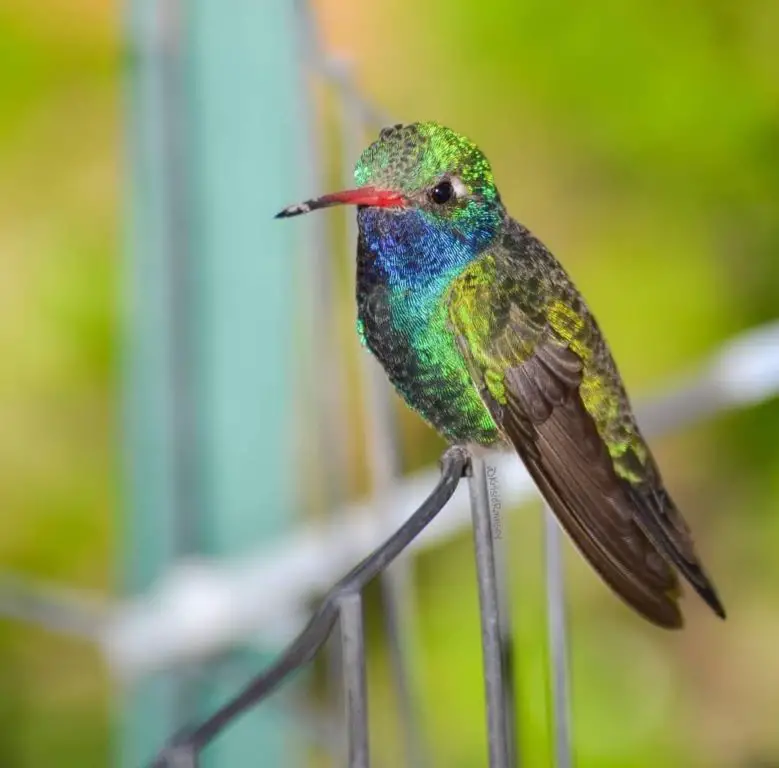
Photo by: krisieramsey
Female Broad-billed hummingbirds are identified with a completely dark bill and a longer white accent above the eyes.
Juvenile male and female Broad-billed hummingbirds are both predominantly metallic green on their topside with a white underbelly. Their tails are dark in color and forked.
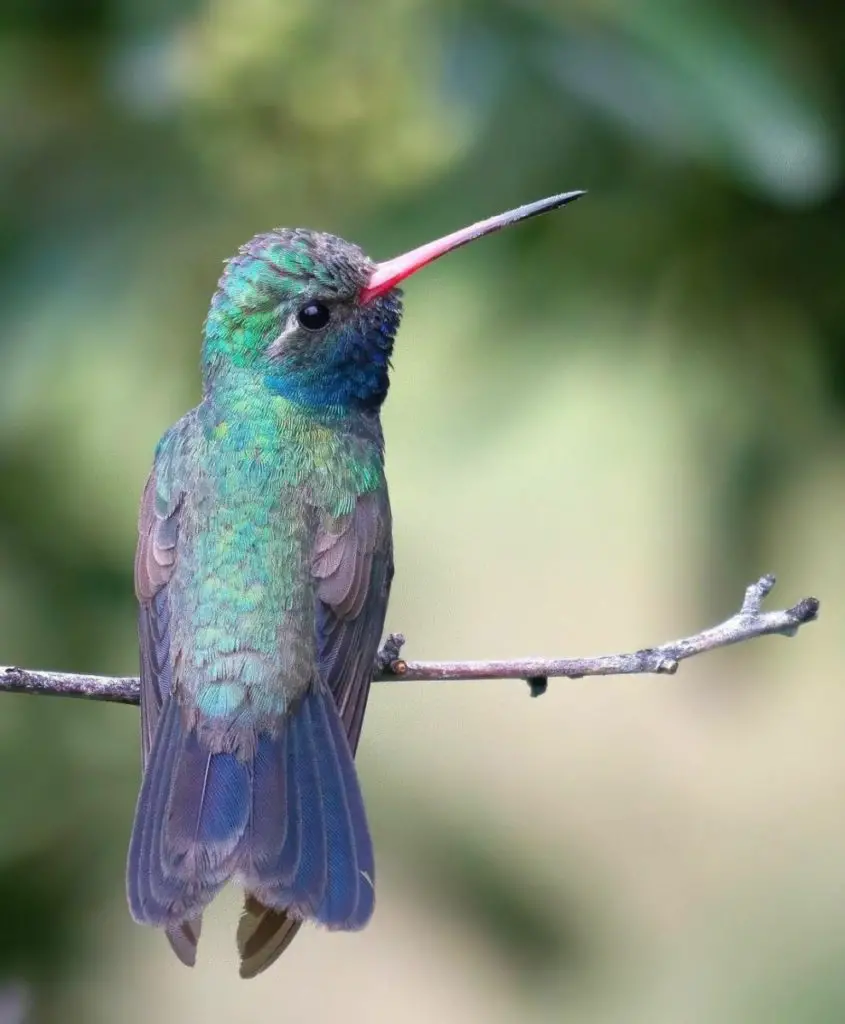
Photo by: Aaron Gomperts
Broad-billed hummingbird nests are distinguishable because they do not decorate the outside of their nests with lichens but instead choose to construct their nests with outside grass fibers, bits of leaves, and bark while using spider webs to glue and hold the nest together. The nest that the female builds hangs on a single long slender branch.
Astonishingly, unlike other hummingbird population counts, the Broad-billed hummingbird has shown an actual general population increase in recent years.
In Arizona, the oldest recorded male Broad-billed hummingbird was 9 years and 1 month old when he was captured and released from a banding operation.
See my article: 3 Reasons Why Hummingbirds Are Banded
See pictures of male, female, and juvenile Broad-billed hummingbirds here…..
Hear sounds of Broad-billed hummingbirds here…..
RIVOLI’S HUMMINGBIRD – (Eugenes fulgens)
Conservation Status: Least concerned
Kingdom: Animalia
Phylum: Chordata
Class: Aves
Order: Apodiformes
Family: Trochilidae
Genus: Eugenes
Species: E. Fulgens
Rivoli’s hummingbirds are a common resident to Nicaragua, therefore they are considered rare/vagrant to the state of Wyoming.
The Rivoli’s (pronounced: rivo-lee) hummingbird has undergone several name changes. In 1983 it was changed to the “Magnificent Hummingbird”, then to “Refulgent Hummingbird” only to have the “Rivoli’s Hummingbird” name return in 2017 when the species was split into two variations (Rivoli’s and Talamanca). Rivoli’s Hummingbird is named in honor of Francois Victor Massena, the Duke of Rivoli, by the ornithologist Rene-Primevera Lesson.
Male Rivoli’s hummingbirds are somewhat dark in color except when they are shown in bright daylight, where their violet crown, bright blue-green gorget, and white eyespots are more apparent through iridescence. They are 4.3 to 5.5 inches in length and weigh 6-10 grams. They are considered the second largest hummingbird in the United States.
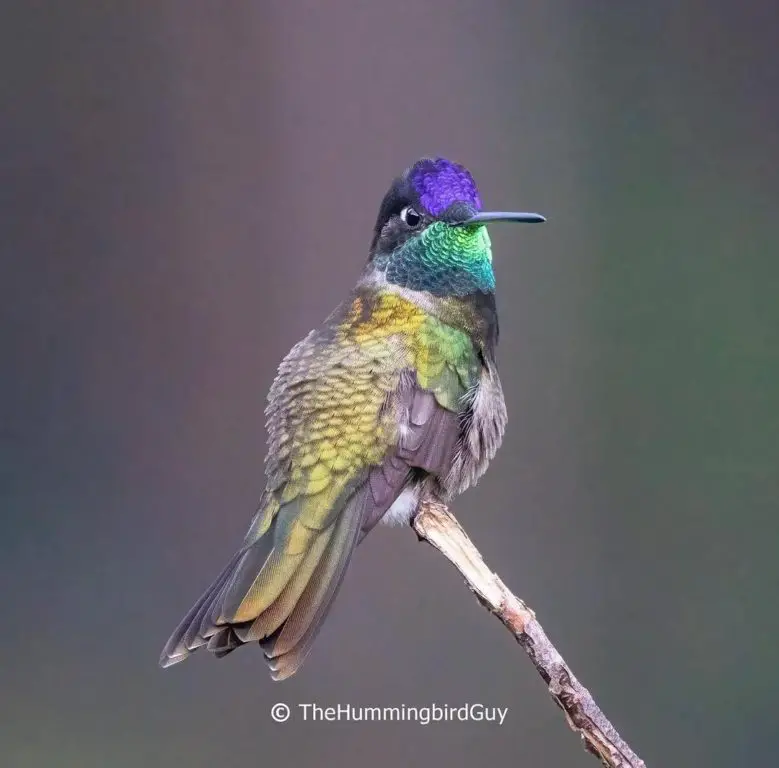
Photo by: TheHummingbirdGuy
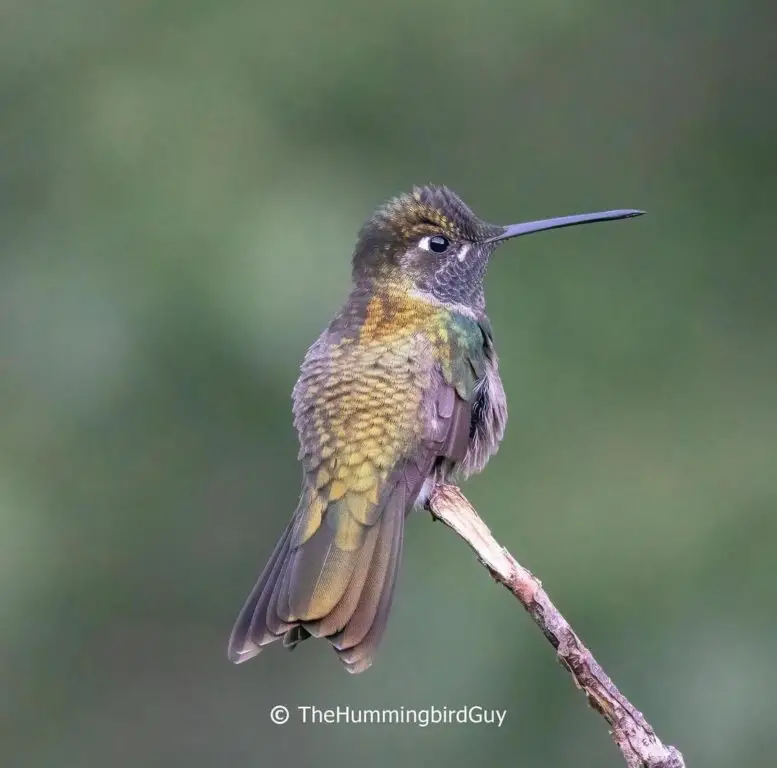
Photo by: TheHummingbirdGuy
Female Rivoli’s hummingbirds have a green head and back with a distinct white patch above the eye. They prefer to live in ravines while feeding in open meadows. Their breeding habitat consists of building nests in evergreen coniferous trees such as pine, fir, and juniper.
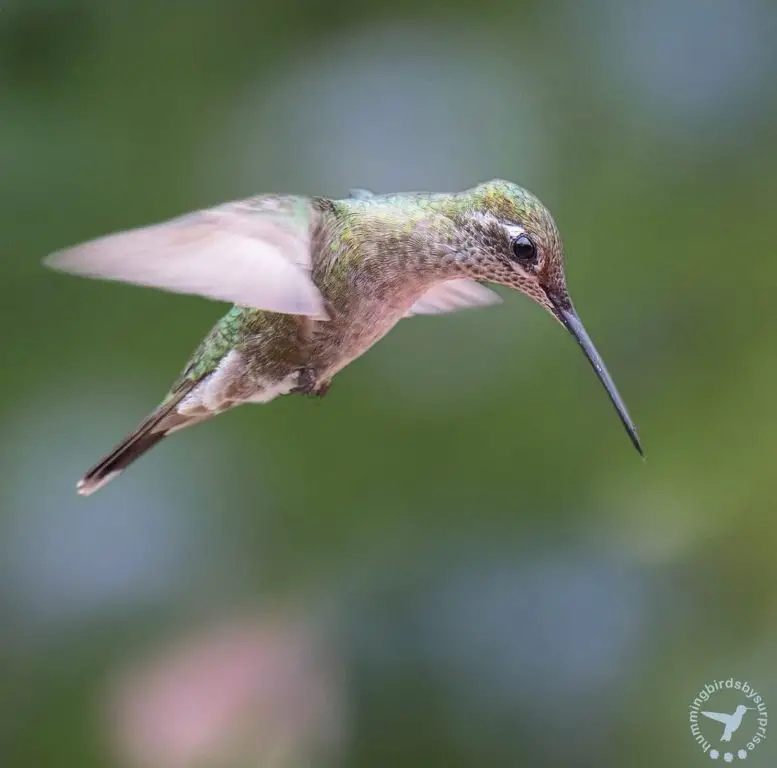
Photo by: hummingbirdsbysuprise
These birds will nest in trees overhanging streams and creeks. They spend the summer in the higher mountains of southeastern Arizona and breed in the late spring then migrate back to western Mexico by November.
They have the highest recorded heart rate of any living vertebrate ranging from 420 to 1,200 beats per minute.
Rivoli’s hummingbirds are known for hybridizing with Broad-billed hummingbirds in the southernmost areas of its habitat range.
See pictures of male, female, and juvenile Rivoli’s hummingbirds here…..
Hear sounds of Rivoli’s hummingbirds here…..
RUBY-THROATED HUMMINGBIRD – (Archilochus colubris)
Conservation Status: Least concerned
Kingdom: Animalia
Phylum: Chordata
Class: Aves
Order: Apodiformes
Family: Trochilidae
Genus: Archilochus
Species: A. colubris
Ruby-throated hummingbirds are a very rare/accidental bird to Wyoming since their main residence is mostly in the midwest and on the east coast of the United States.
The Ruby-throated hummingbird’s scientific name originated from Carl Linnaeus, a Swedish botanist, who first listed this scientific classification as “Trochilus colubris”. Its name changed over a hundred years later and was reclassified by Ludwig Reichenbach, a German botanist to “Archilochus colubris”, which is its current scientific name, meaning “top thief” or “sky spirit/sun-god bird”.
Male Ruby-throated hummingbirds have a striking iridescent blood-red gorget, stopping at the neckline. He is identified with a dull metallic green topside, a light gray underbelly, and black wings. The Ruby-throated hummingbird is a smaller species of hummingbirds weighing less than 4.5 grams or 2 U.S. dimes and is 2.8 to 3.3 inches in length. Their lifespan is approximately 3-5 years.
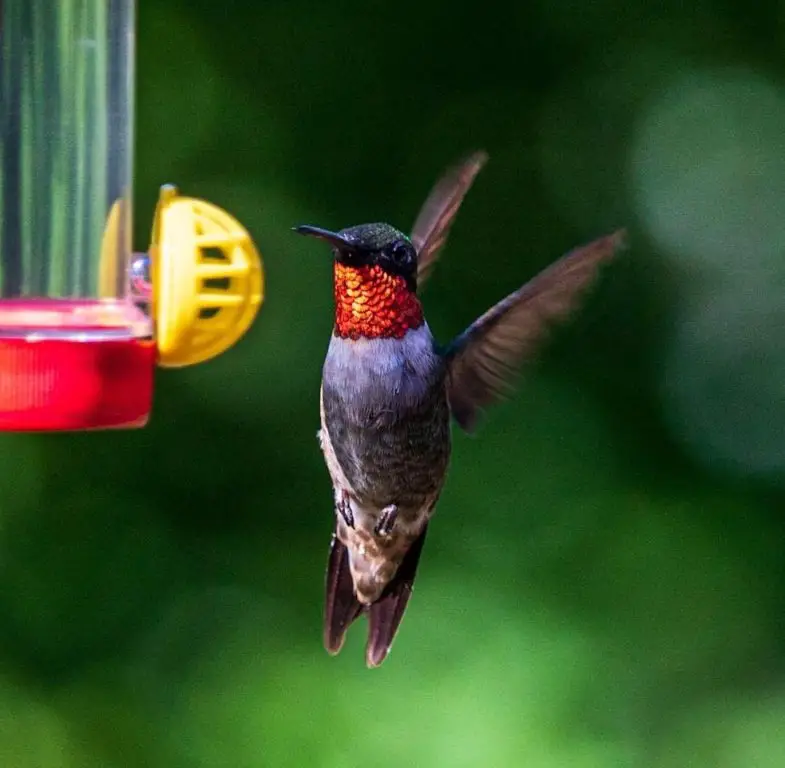
Photo by: MaryLou Ziebarth

Photo by: paulapaintsart
Female Ruby-throated hummingbirds have a white throat with some light stippling and are typically larger than the males. The oldest female Ruby-throated hummingbird has been recorded at 9 years, almost double that of the male.
However, the average lifespan of a Ruby-throated hummingbird is approximately 3-5 years.
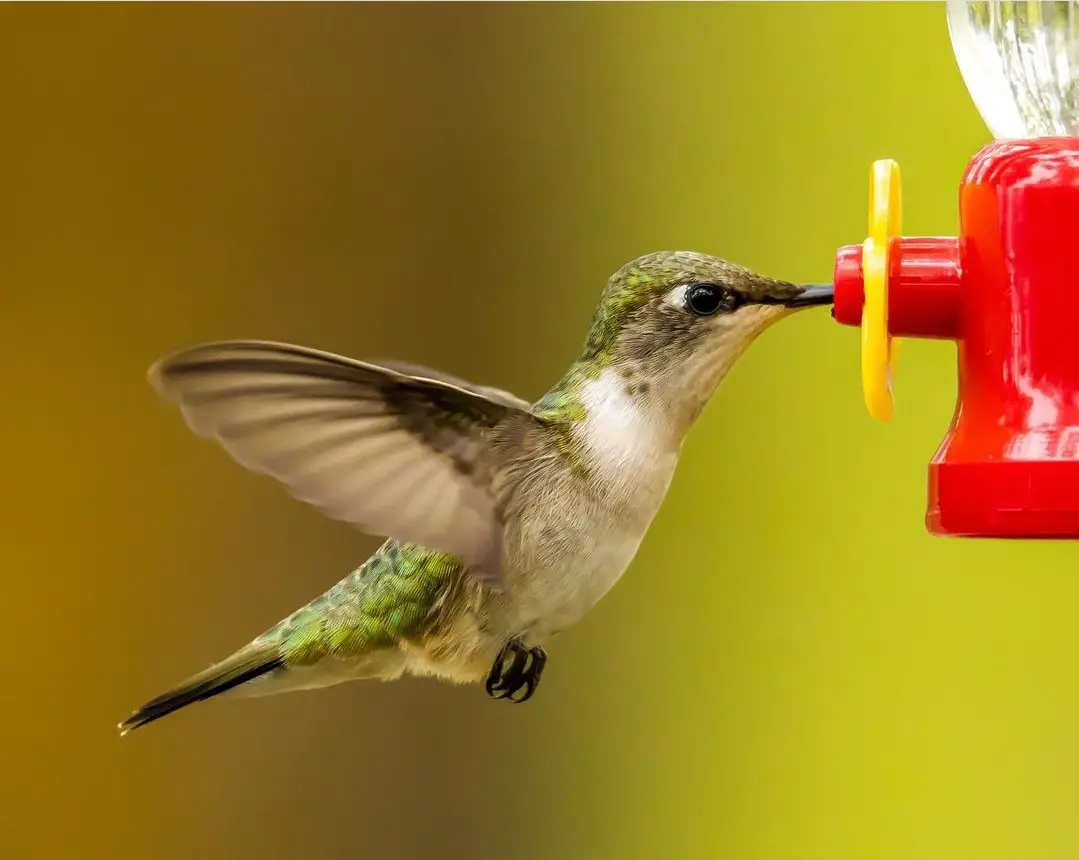
Photo by: MaryLou Ziebarth
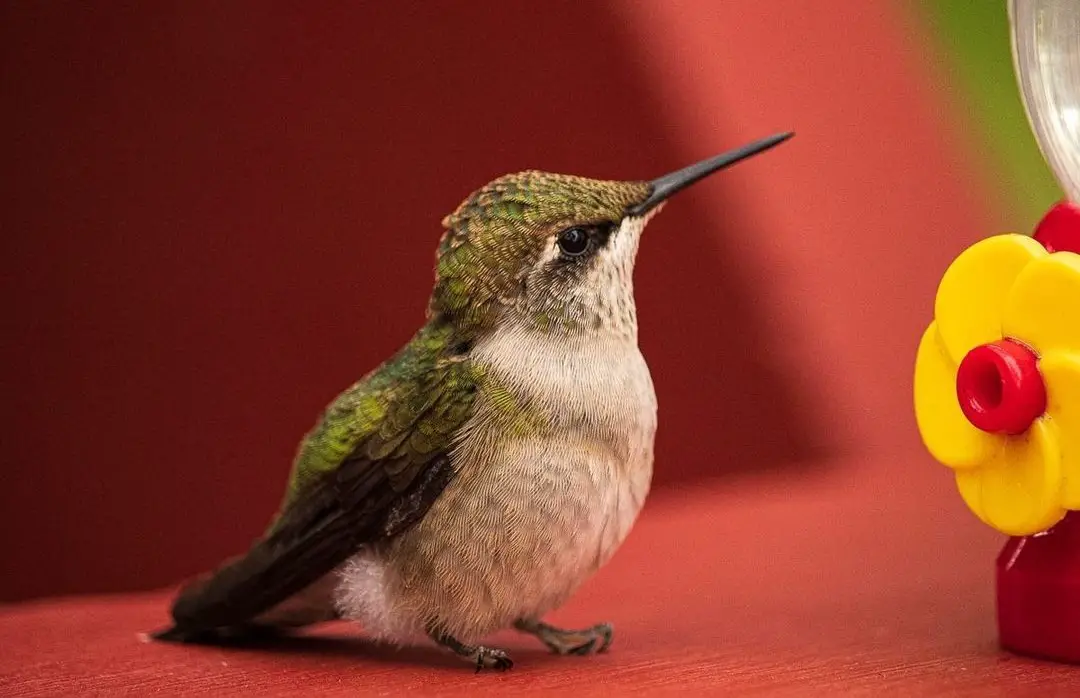
Photo by: MaryLou Ziebarth
Note: The newly white fluffy down feathers on this baby/juvenile Ruby-throated hummingbird’s bottom. Also, notice the nice fat reserves they have accumulated by being fed by their diligent mother which will sustain them through adolescence.
Juvenile male and female Ruby-throated hummingbirds during their initial stages of life resemble their mother exhibiting a white throat with light stippling.
As the males mature, they begin to display a few specks of color near their neckline and eventually their bolder red throat feathers become more dominant and stately displaying a colorful gorget.
Juvenile females show a light faint grey stippling on their throat. As both sexes mature their less vivid and lighter colored plumage will begin to mature and become darker in color.
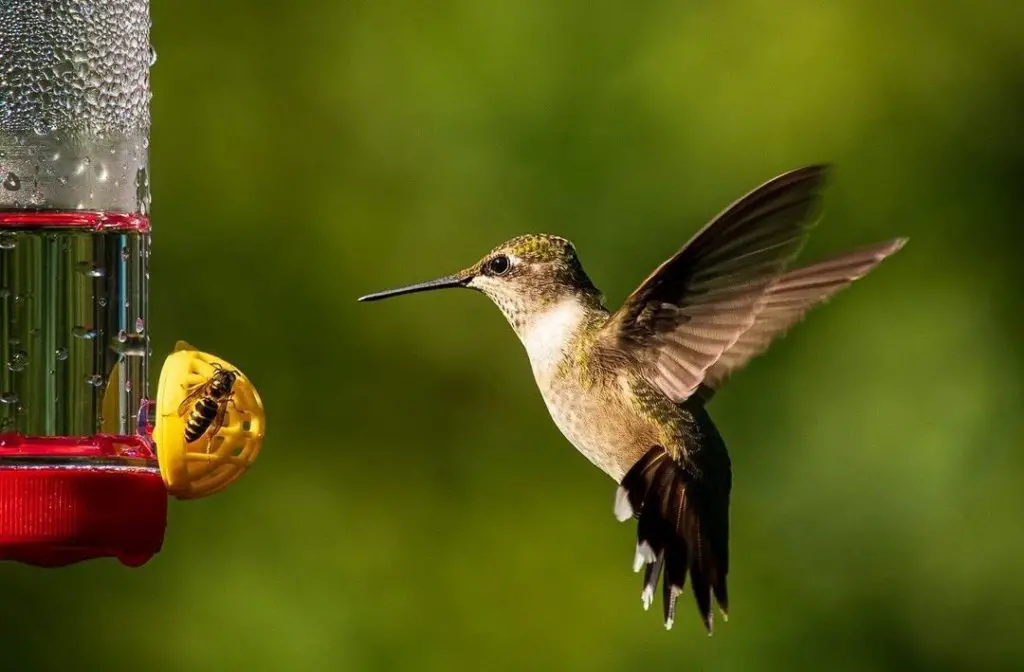
Photo by: MaryLou Ziebarth
Note: This juvenile Ruby-throated hummingbird is struggling with a bee or wasp situation at the feeder.
See my article: Bees On My Hummingbird Feeder: (9 Tips To Get Rid of Them)
There are two migration routes for the Ruby-throated hummingbird during the spring and fall migrations.
The first migration route is a direct but exhausting nonstop journey southwest over the Gulf of Mexico to Mexico and then down to Central America for the winter. The flight distance over the Gulf of Mexico is over 500 miles. Although this is the direct “short” route, there are numerous obstacles faced by these birds.
Some obstacles include not being able to rest, having no means to refuel or eat, and having to avoid the dangerous tropical Atlantic hurricanes while flying to their destination. To make matters worse, depending on how you look at it, they migrate during the dark hours of the night or are taking the “Red-eye flight”.
Researchers believe their small size makes the energy expenditure of their grueling trans-oceanic migration pattern more taxing for males than for females even though they both double their body’s fat prior to making the migration across the Gulf of Mexico.
The second migration route is over 2,000 miles, flying along the coastline outlining the Gulf of Mexico. Although this is the “long” route, it allows the opportunity to rest and refuel even though there are fewer food source guarantees along the way.
Scientists are unclear and continue to investigate as to why one group of birds would prefer to take one route over the other.
See my article: Hummingbird Migration in Wyoming
Ruby-throated hummingbirds prefer open woodlands and are often seen in parks, gardens, and backyards. They are solitary birds except during mating periods when they are fiercely territorial and aggressive towards hummingbirds of other species.
Even though these hummingbirds have an aggressive side they can still be eaten by predators such as large invertebrates, praying mantises, orb-weaver spiders, and dragonflies.
See my article: 10 Common Things That Kill Hummingbirds
See pictures of male, female, and juvenile Ruby-throated hummingbirds here…..
Hear sounds of Ruby-throated hummingbirds here…..
WHITE-EARED HUMMINGBIRD – (Hylocharis leucotis)
Conservation Status: Least concerned
Kingdom: Animalia
Phylum: Chordata
Class: Aves
Order: Apodiformes
Family: Trochilidae
Genus: Hylocharis
Species: H. leucotis
White-eared hummingbirds are a common resident to Mexico and Nicaragua, therefore they are considered rare/vagrant to the state of Wyoming.
Adult male White-eared hummingbirds have a spectrum of green colors on their back ranging from a Granny Smith apple green to dark emerald with patches of iridescent turquoise on their throats. In darker lighting, their crown and throat can appear black. They possess a distinct and noticeable white stripe that spans from the eye to the neck. Their bill is shorter than the average hummingbird bill and is half red and black. Their size ranges from 3.5 inches to 3.9 inches in length and weighs 3-4 grams.
The White-eared hummingbird’s scientific name is Basilinna leucotis, but its higher classification name that most people use is Hylocharis leucotis which is a combination of the genus name Hylocharis and species name Leucotis. The White-eared hummingbird gets its scientific name from the Latin word (hylo) “wood or matter,” (charis) derived from a Greek word meaning goddesses of beauty and grace; (leuco) in Latin means “white or without color” and (otis) meaning “ear”.
These species of hummingbirds are found on the edge of cloud forests from Mexico to Nicaragua where they prefer constant rainfall and tropical humidity in their environment.
See pictures and hear sounds of White-eared hummingbirds here…..
See my article: Hummingbird Migration in Wyoming
Keep your eyes peeled, observe and enjoy the multiple types of hummingbirds found in Wyoming!
Happy Hummingbird Watching!
Backyard Visitors participates in affiliate programs which compensate us for referring traffic.

